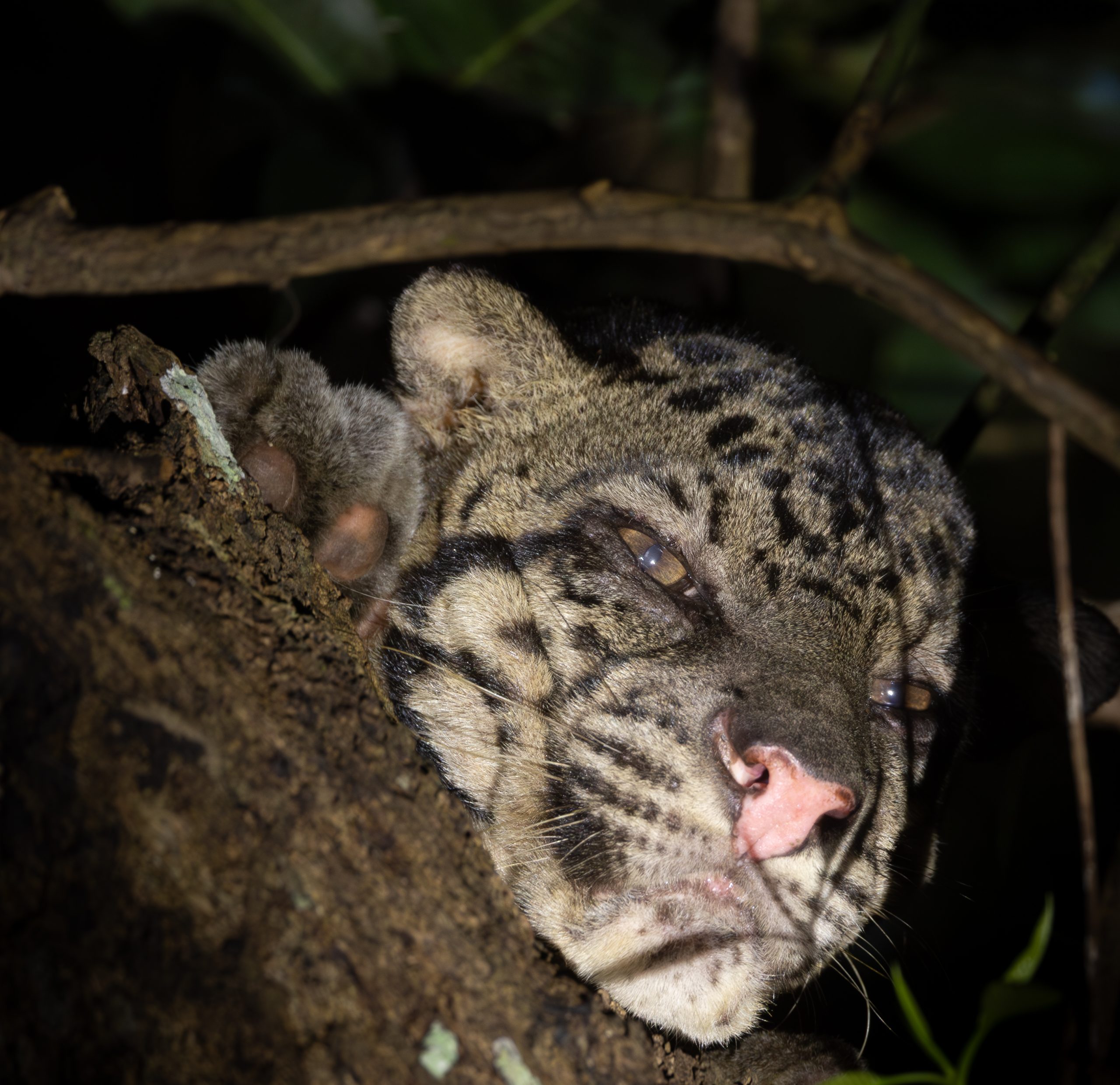
Sabah, 2025: Some ‘New’ Sites
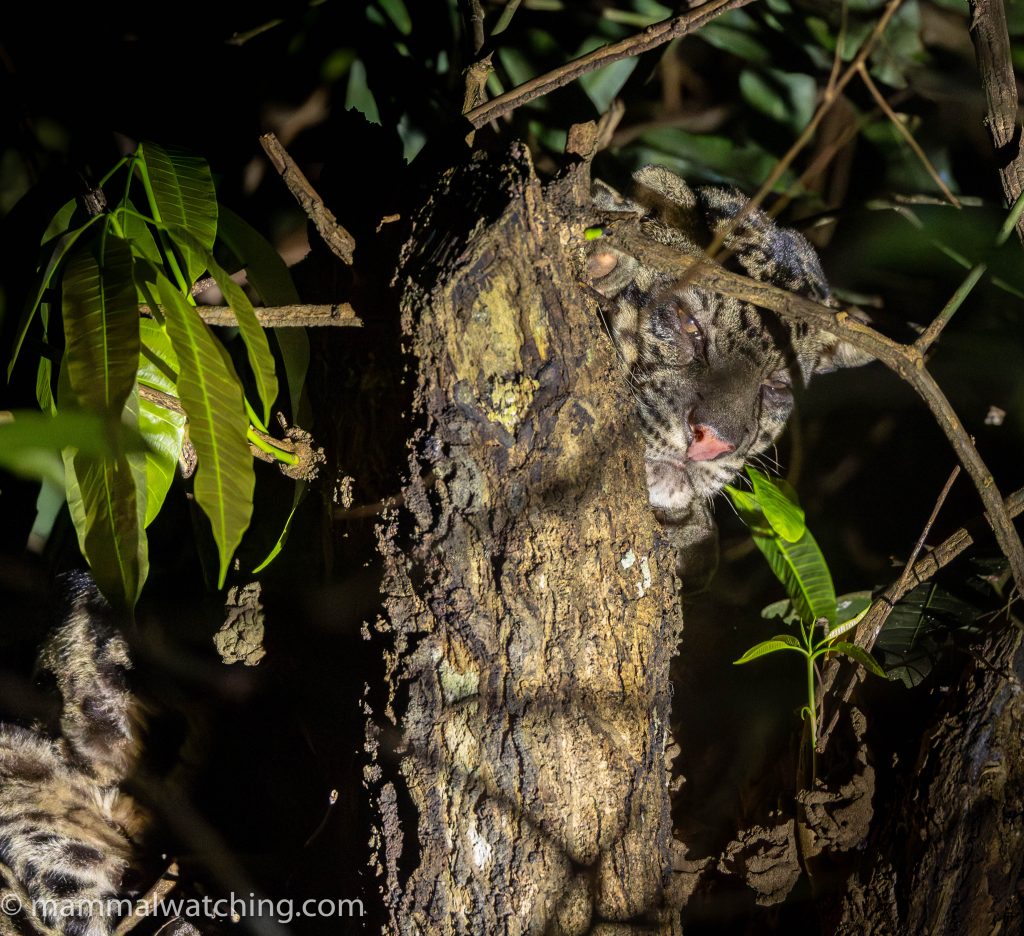
Sunda Clouded Leopard (Neofelis diardi), Kinabatangan River
Borneo ticked all the boxes.
I wanted to spend a week with my kids somewhere close to Australia. My son Patrick would love the herps and insects. Kylie, his partner, was fully on board with the idea of seeing her first wild primates (if you exclude Patrick who many would not). And even my daughter Katy expressed enthusiasm at the prospect of Orangutans. Borneo was safe, comfortable and, though I had been four times before, the island is home to many mega-mammals I still haven’t seen, including three from my most wanted list: Marbled Cat, Otter Civet and Tufted Ground Squirrel.
Perfect.
And then I realized how much it would cost for the five of us. Though that in fact wasn’t such a problem when I discovered that most of the places I thought of visiting were fully booked.
Borneo has gotten both popular and expensive.
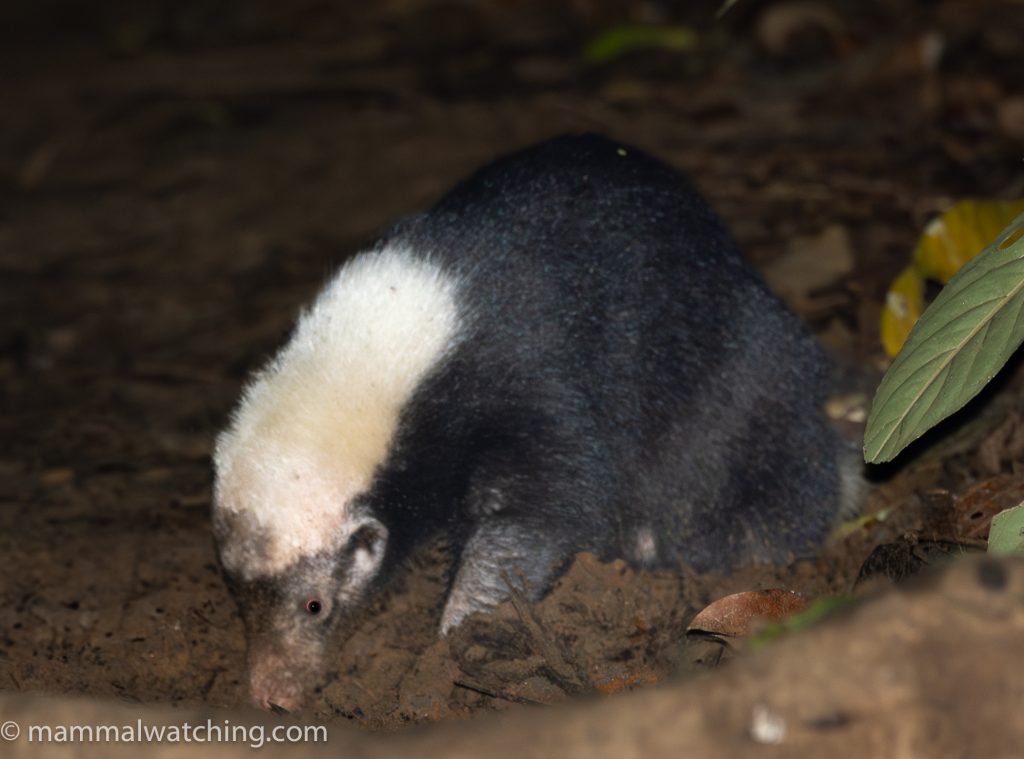
Sunda Stink Badger (Mydaus javanensis), Tawau Hills
But all was not lost. I wrote to Shavez Cheema, from 1StopBorneo Wildlife. If you heard Shavez on the May 2025 episode of the Mammalwatching Podcast you may remember he’s trying to promote mammalwatching in areas of Borneo that were still little visited. This sounded like the solution I needed.
A few days later we had a trip sketched out, visiting three of Shavez’s ‘new’ sites, plus Sayap, in the foothills of Mount Kinabalu and a night on the – now very much visited – Kinabatangan River for Proboscis Monkeys and Orangutans.
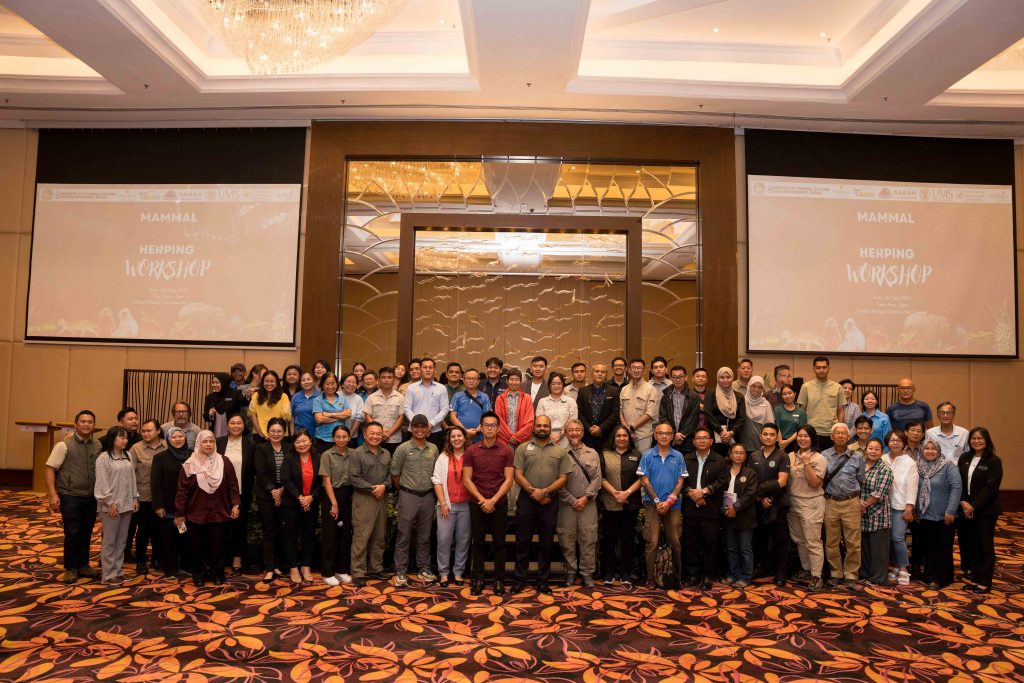
Mammalwatching & Herping delegates
Shavez also found time to arrange a mammalwatching workshop in Kota Kinabalu while I was there. I confess I was a little skeptical about whether this event would be attended by anyone. Was it really worth giving up a few hours of my day talking to an empty room which I could have otherwise spent doing something more worthwhile. By which I mean gorging myself on Roti Canai in KK.

The golden age of mammalwatching
How wrong I was! Shavez filled the room with a hundred or so professionals from the tourist industry, the university and government officials, including the head of the Sabah Tourism Ministry who funded the event. And among the audience I was very happy to finally meet Jens Hauser who had taken a day off from yet another trip to try to see a Sunda Clouded Leopard.
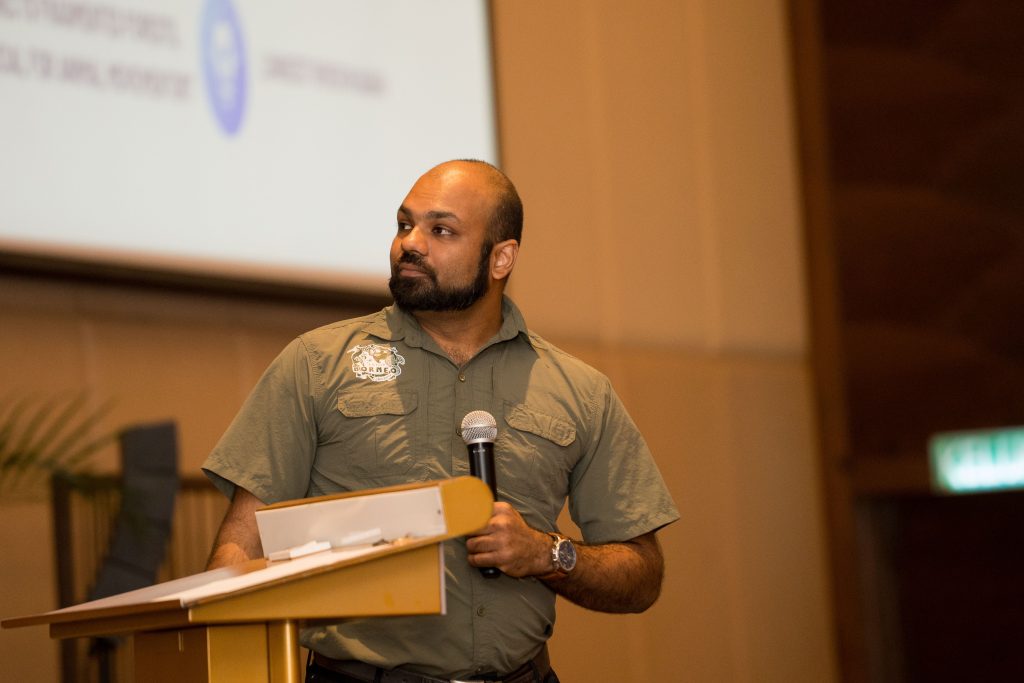
Shavez in full flow
It felt as if mammalwatching’s time had arrived. My talk argued that we live in the golden age of mammalwatching. But it also felt that this might be the golden age to set up a mammalwatching tour company!
We – if you are reading this then that ‘we’ surely includes you – we can say “and we were here first.”
I love seeing all this mammal energy around the world. It also demonstrates how valuable it is for people like Shavez to spread the mammal-love to new areas and new communities. There is significant conservation potential to this expanding interest. Plus, if you are as disorganized as me, there will be space for you somewhere.
Shavez and his team organized our trip brilliantly. He was with us for most of the trip, and his business partner – and herp fanatic – Chun Wong looked after us in Sayap. Kat , a mammalwatcher from the UK, also joined us. It was a whistle-stop tour that would have been better suited to a slightly longer itinerary, but I wanted to check out as many of the new sites as I could.
Sayap Substation, Kinabalu Park
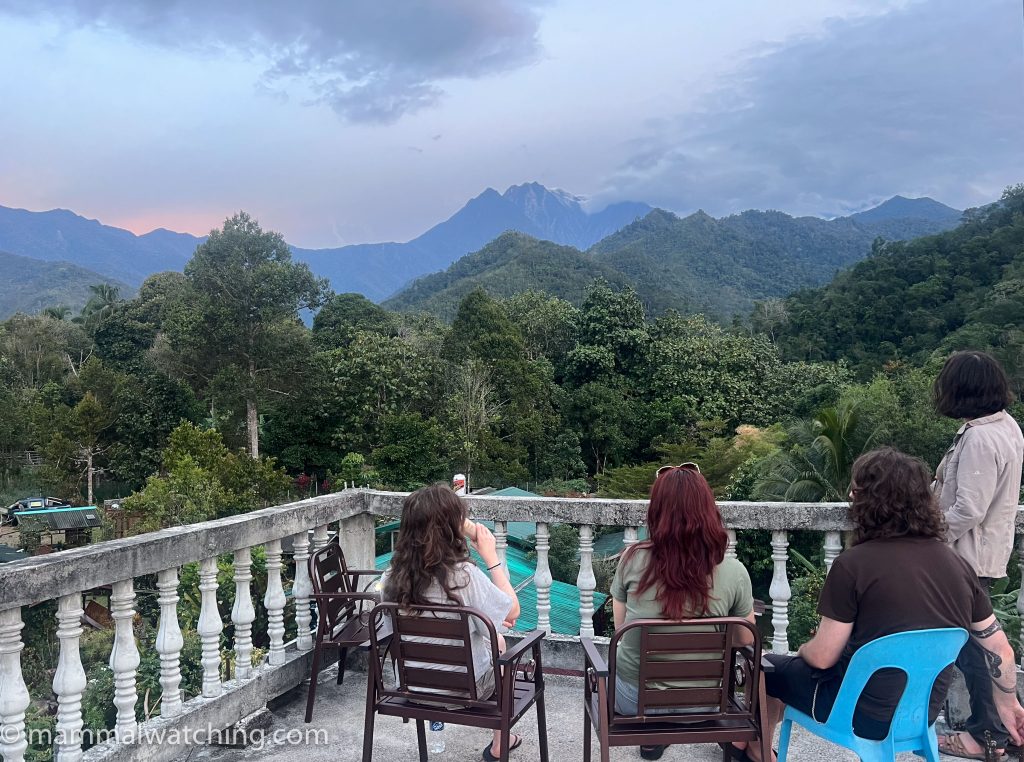
I visited Sayap Substation in 2022 and more details are in my report. This protected area, in the foothills of Mount Kinabalu, is a 2 – 4 hour drive from Kota Kinabalu depending on the traffic, which is often very heavy. Once again we stayed at the Porohon Garden Lodge.

Masked Palm Civet (Paguma larvata)
The park have tightened up on rules since I last visited. Night walks are now limited to two hours for reasons no one could explain. The 1StopBorneo team have been camera trapping in the area and have recorded some good mammals, including Hose’s Civet, Kinabalu Ferret Badger and Tufted Ground Squirrel. Athough from what I could gather, both the civet and ferret badger were photographed several kilometres into the park, at a spot too far to reach on a two hour walk.
We took a night walk with Chun and found a Binturong and a Masked Palm Civet in a fruiting fig as well as at least 100 frogs.
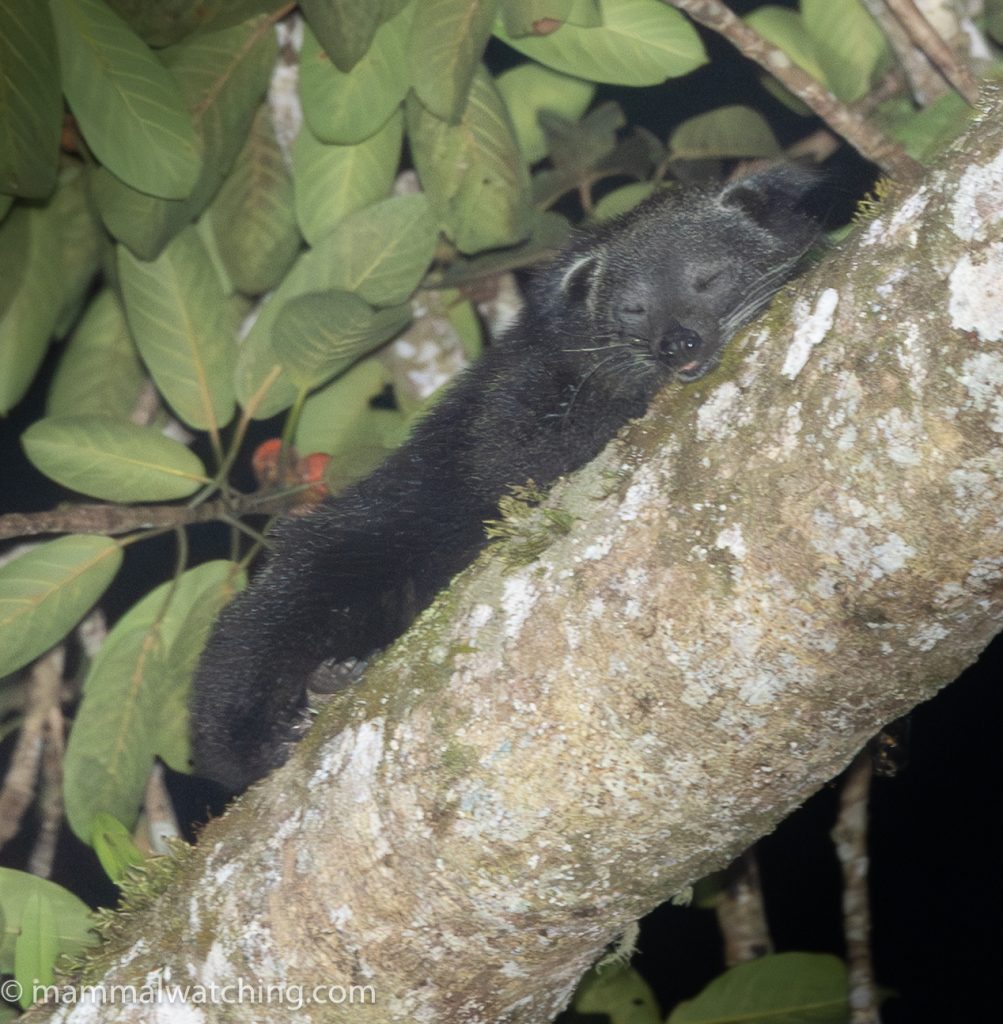
Binturong (Arctictis binturong)
I saw a Leopoldamys sabanus (Indomalayan (Sabah) Long-tailed Giant Rat), which are common here according to Chun, but which I couldn’t photograph.This rat which was spiny and red so probably …. a Red Spiny Rat..
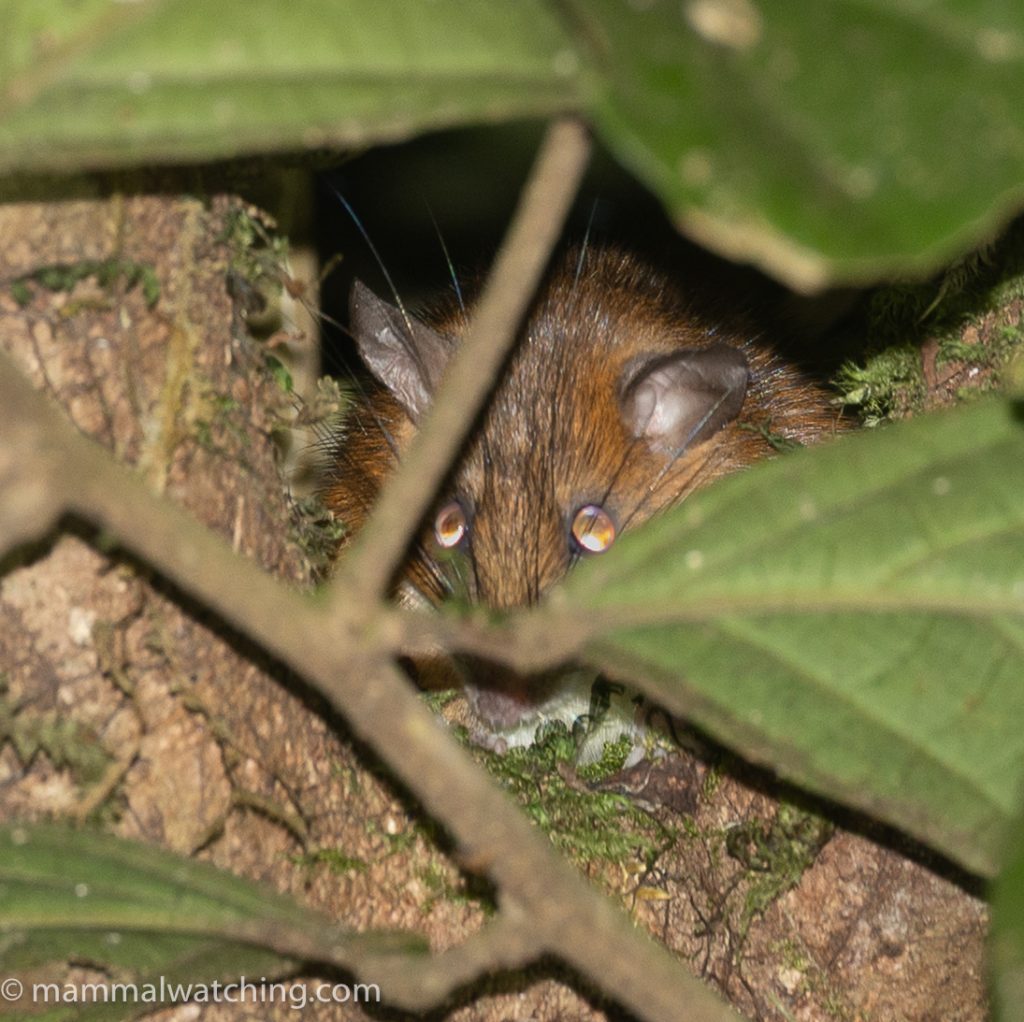
Indomalayan Spiny Rat (Maxomys surifer)
This Diadem Leafnosed Bat hanging from a hunting perch was unusually relaxed and didn’t fly even when we were standing directly underneath it.
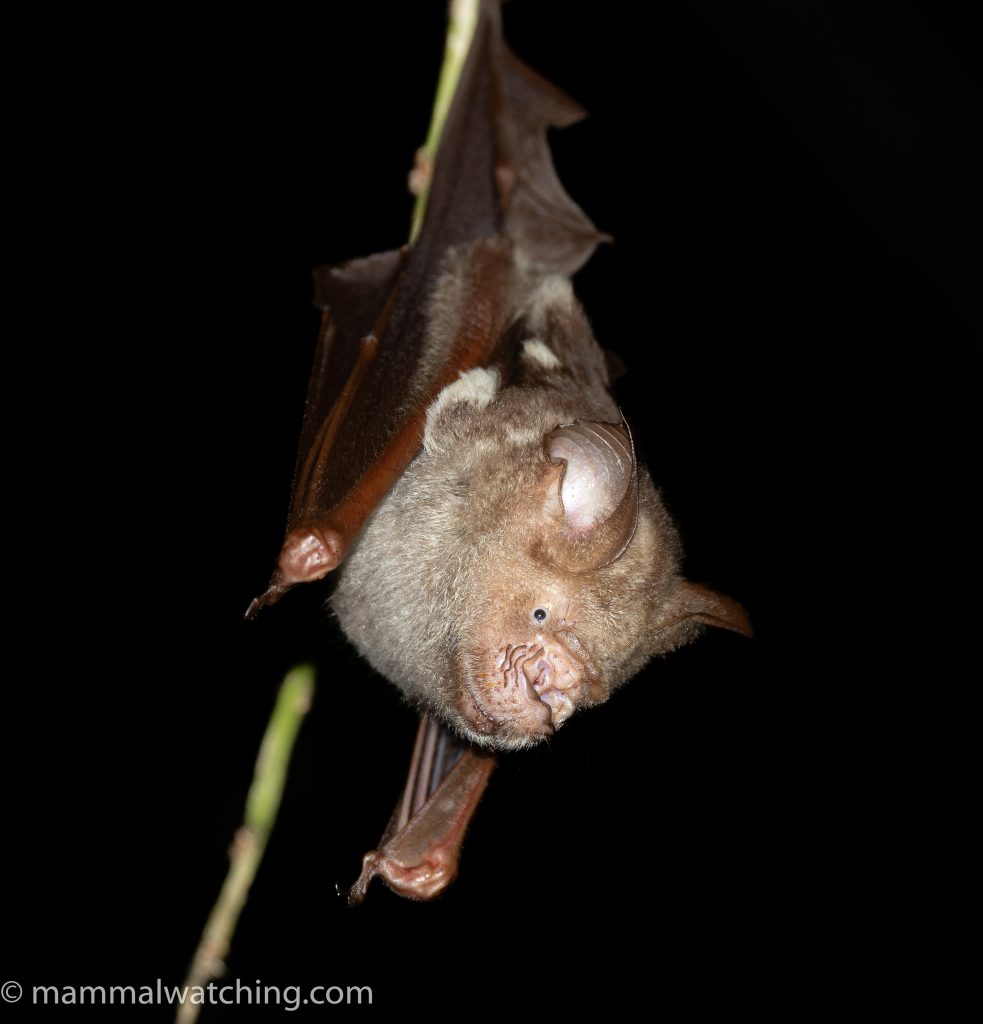
Diadem Leaf-nosed Bat (Hipposideros diadema)
We returned the following morning and saw a lone Pig-tailed Macaque at the entrance, which pleased Chun because it suggested hunting pressure in the park was declining.
Eastern Grey Gibbons were hooting in the distance while I staked out the huge fig tree about a hundred metres along the trail. I was hoping a Tufted Ground Squirrel might appear. It didn’t, but I did see this Whitehead’s Pygmy Tufted Squirrel.
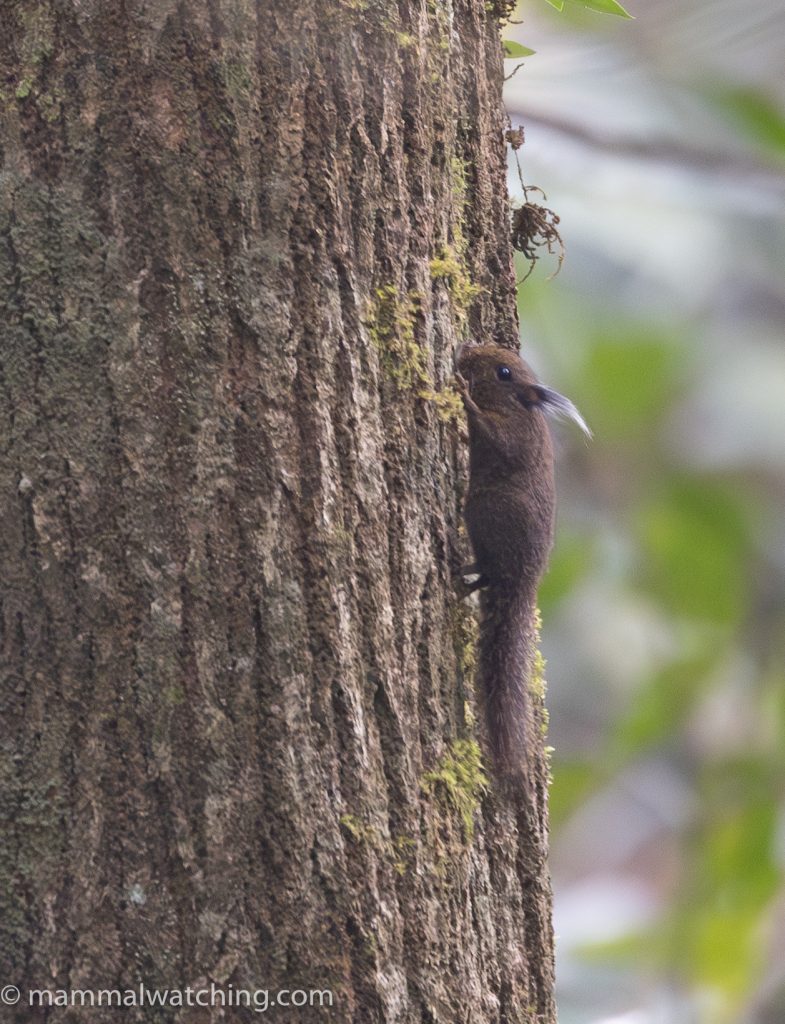
Tufted Pygmy Squirrel (Exilisciurus whiteheadi)
A group of very high and very active Sculptor Squirrels appeared too. These photos are terrible but they are seldom photographed and so I include three pictures in case someone finds them interesting.
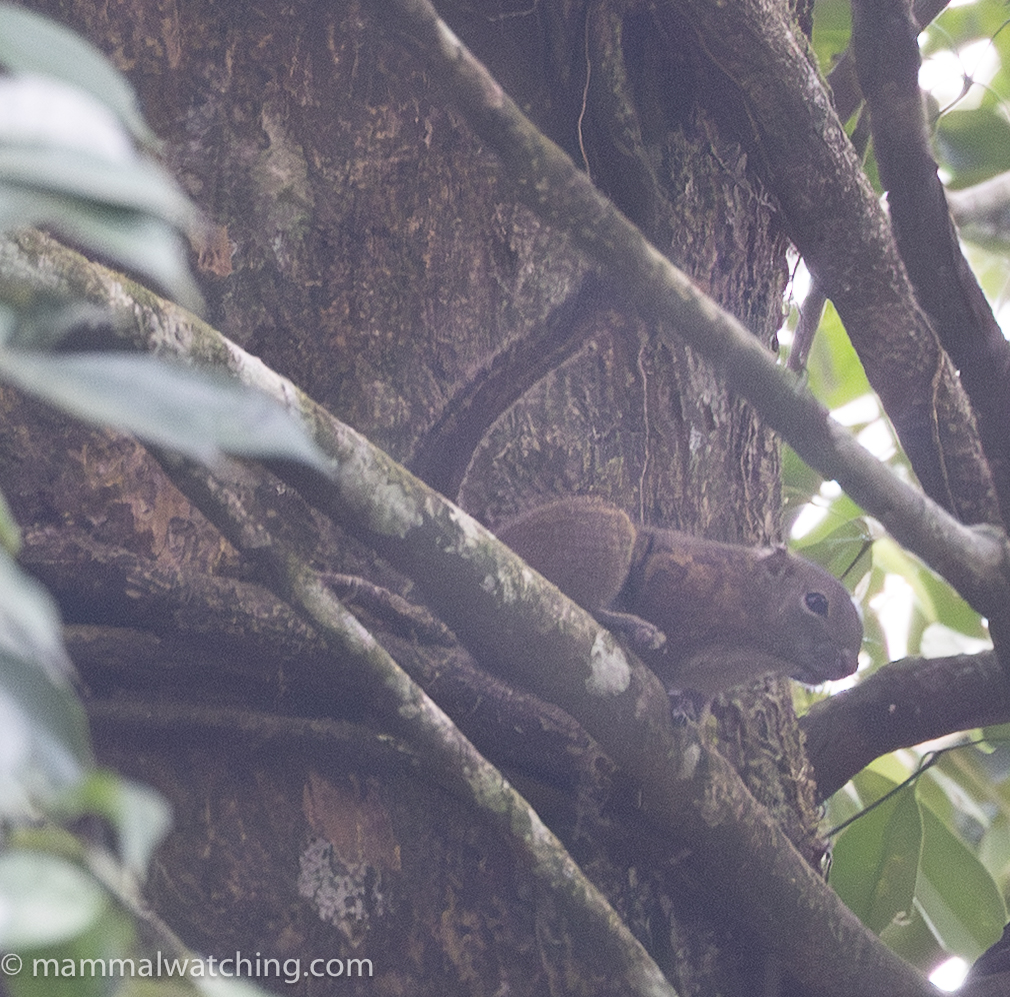
Sculptor Squirrel (Glyphotes simus)
I have only seen Sculptor Squirrels once before, in this same tree in 2022.
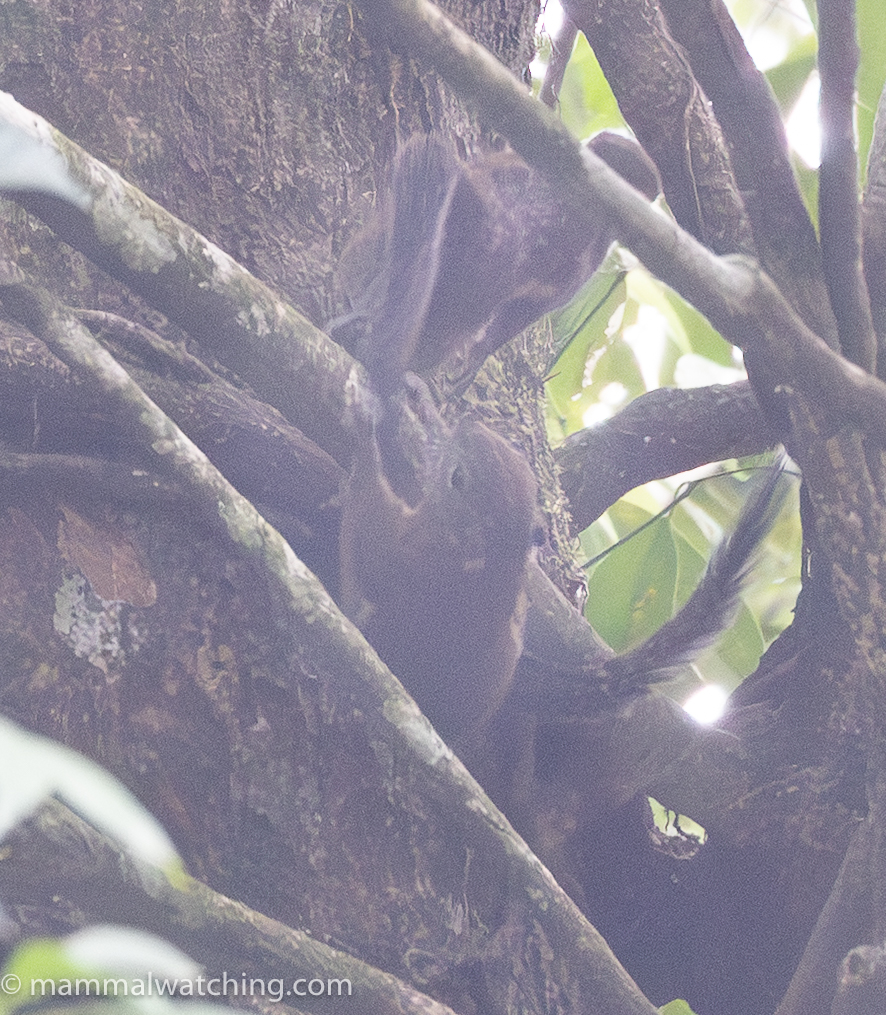
Sculptor Squirrel (Glyphotes simus)
Sculptor Squirrels are an interesting species that are reported to spend much of their time hanging upside down to feed on latex from the underside of leaves. This appears to give them boundless energy: they never stop moving.
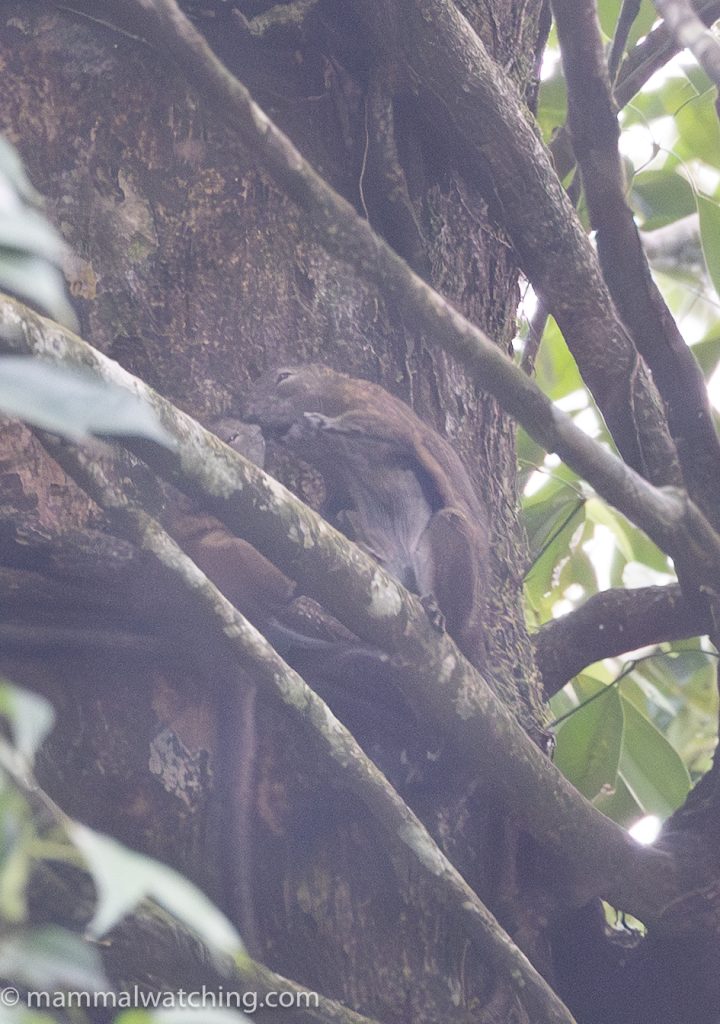
Sculptor Squirrel (Glyphotes simus)
I was excited to be able to do some batting at Sayap with local researchers. They set a harp trap and a couple of nets around the Porohon Hotel and we caught some interesting species over the two nights, particularly in the net strung across the river in forest just below the hotel.

Greater Dawn Bat (Eonycteris major)
Over the course of the two evenings we caught a single Greater Dawn Bat, a lifer for me.
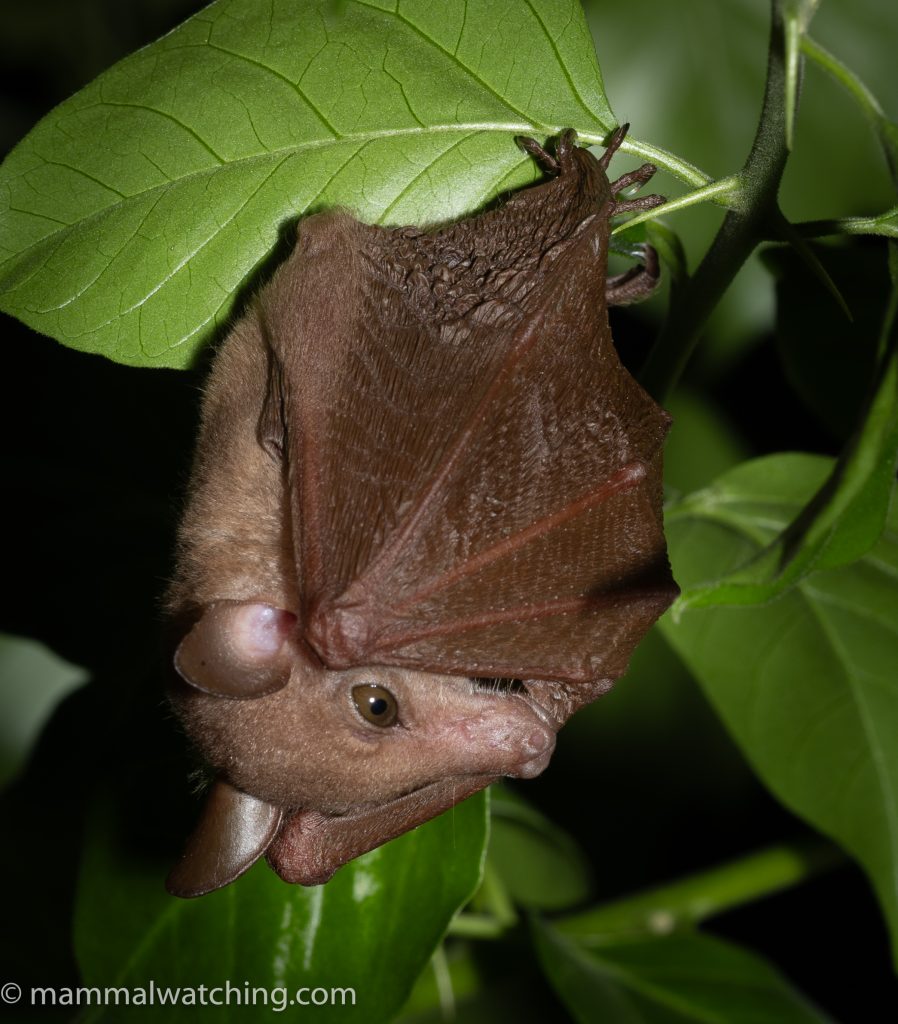
Lesser Long-tongued Blossom Bat (Macroglossus minimus)
We also caught two Lesser Long-tongued Blossom Bats and two species of short-nosed, cynopterus, fruit bats.
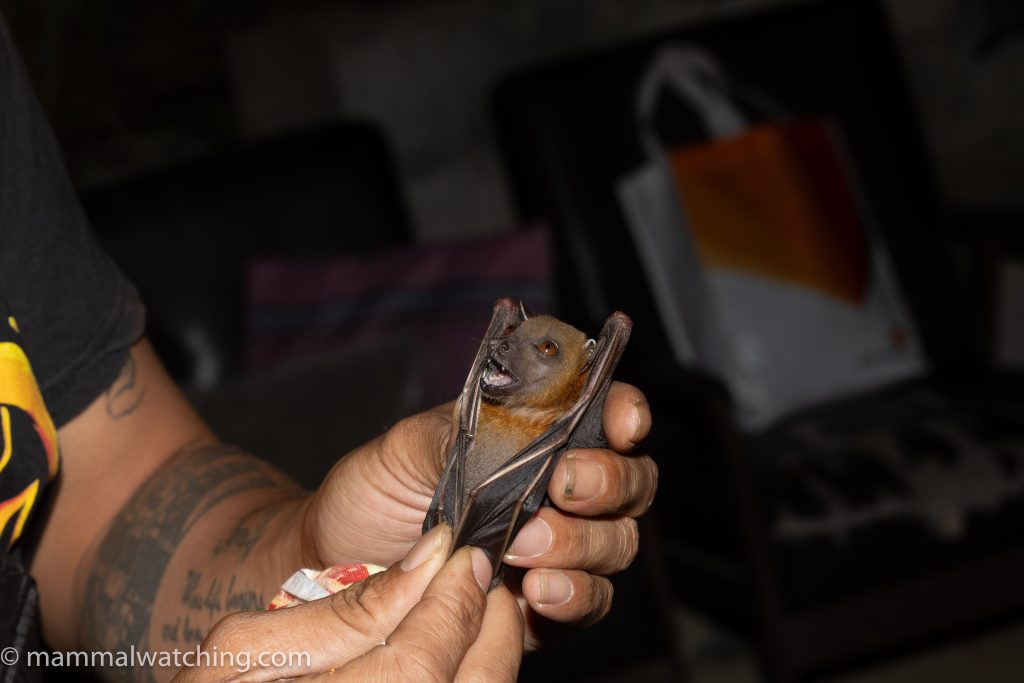
Lesser Short-nosed Fruit Bat (Cynopterus brachyotis)
This is a Lesser Short-nosed Fruit Bat (with a forearm of 63mm).
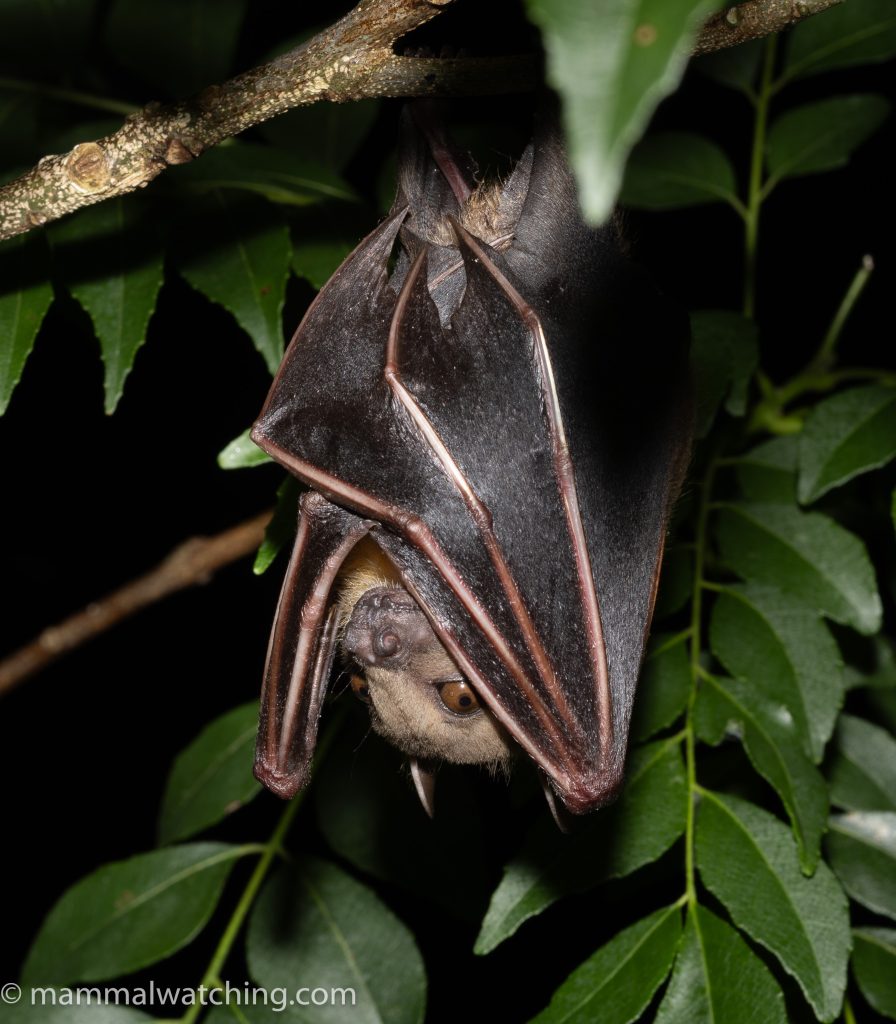
Minute Short-nosed Fruit Bat (Cynopterus minutus)
And this is the slightly smaller Minute Short-nosed Fruit Bat (with a forearm of 58mm). The two species are similar looking and I am not sure how to distinguish them without measuring their forearms.
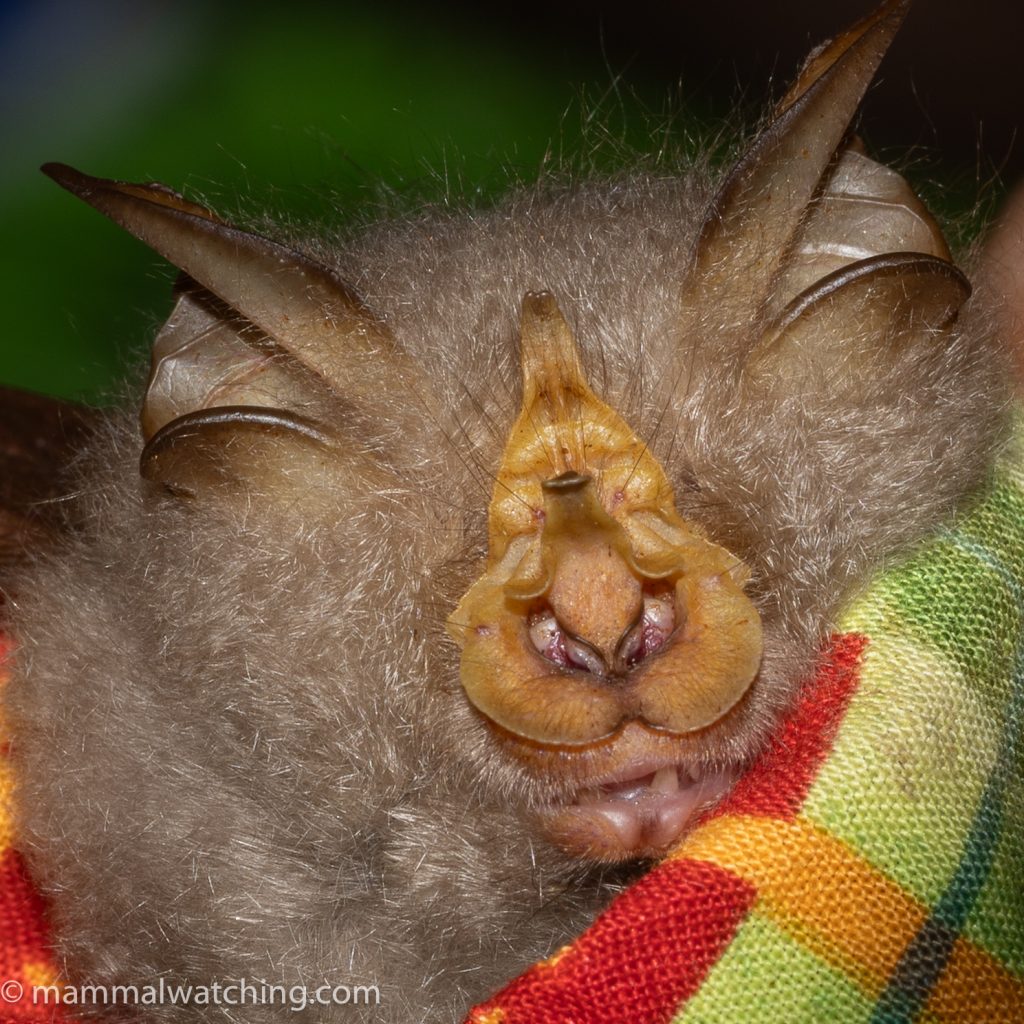
Trefoil Horseshoe Bat (Rhinolophus trifoliatus)
This Trefoil Horseshoe Bat was easier to identify, and was the only capture in the harp trap.
A net across the river below the lodge caught three vesper bats, all of which were lifers for me, even if I am still not sure what two of these species are despite getting help from Malaysian bat experts.
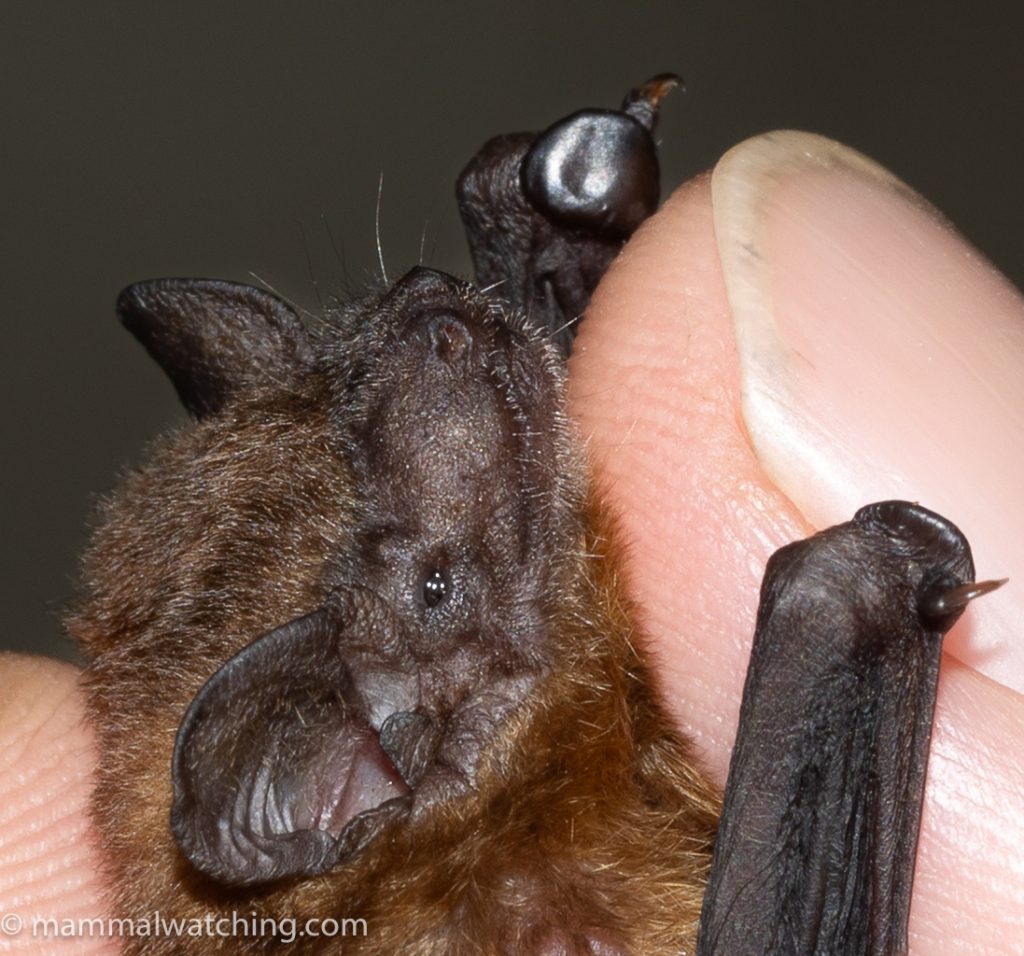
Sumatran Greater Bamboo Bat (Tylonycteris robustula)
This Sumatran Greater Bamboo Bat is identifiable from the large disc-like pads on its thumbs.
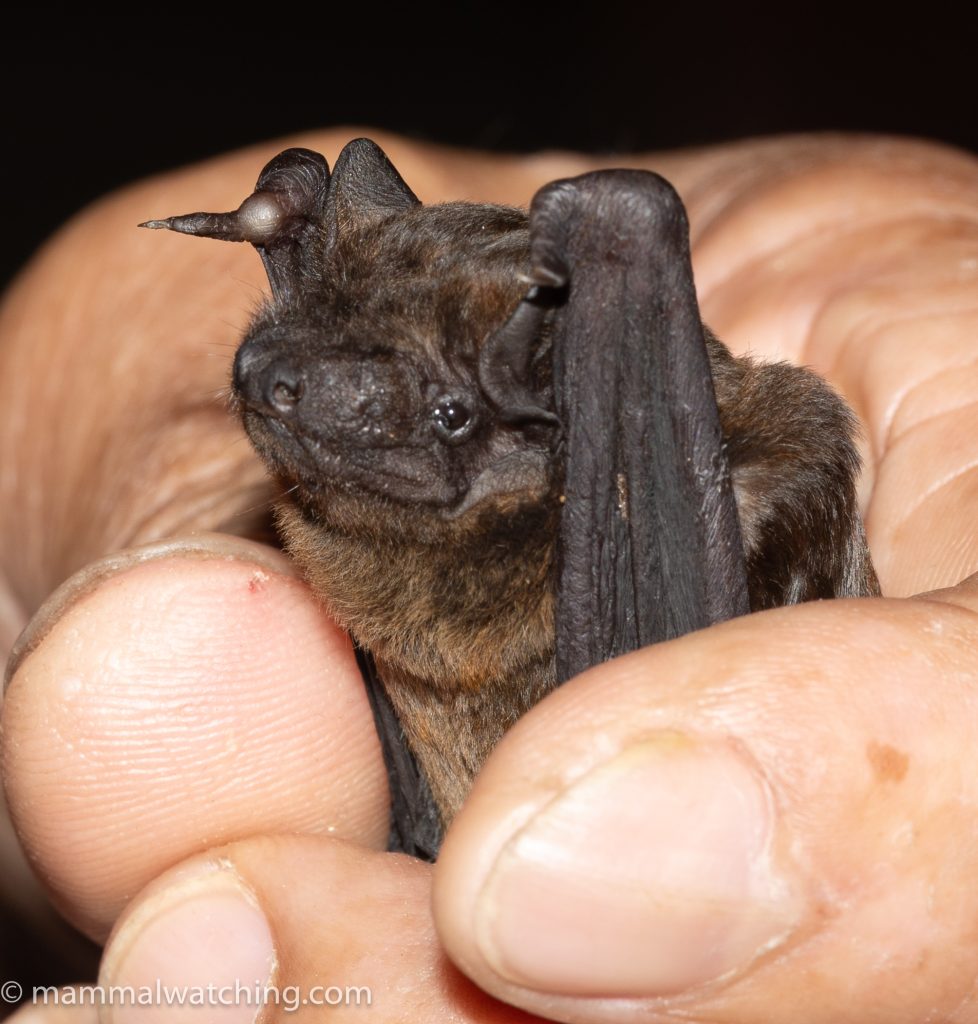
Doria’s False Serotine (Hesperoptenus doriae)
This species appears to be a false-serotine but the species is still a bit of a mystery. With a forearm of 39mm it could be Doria’s False Serotine on the basis of size among the known options from Borneo.
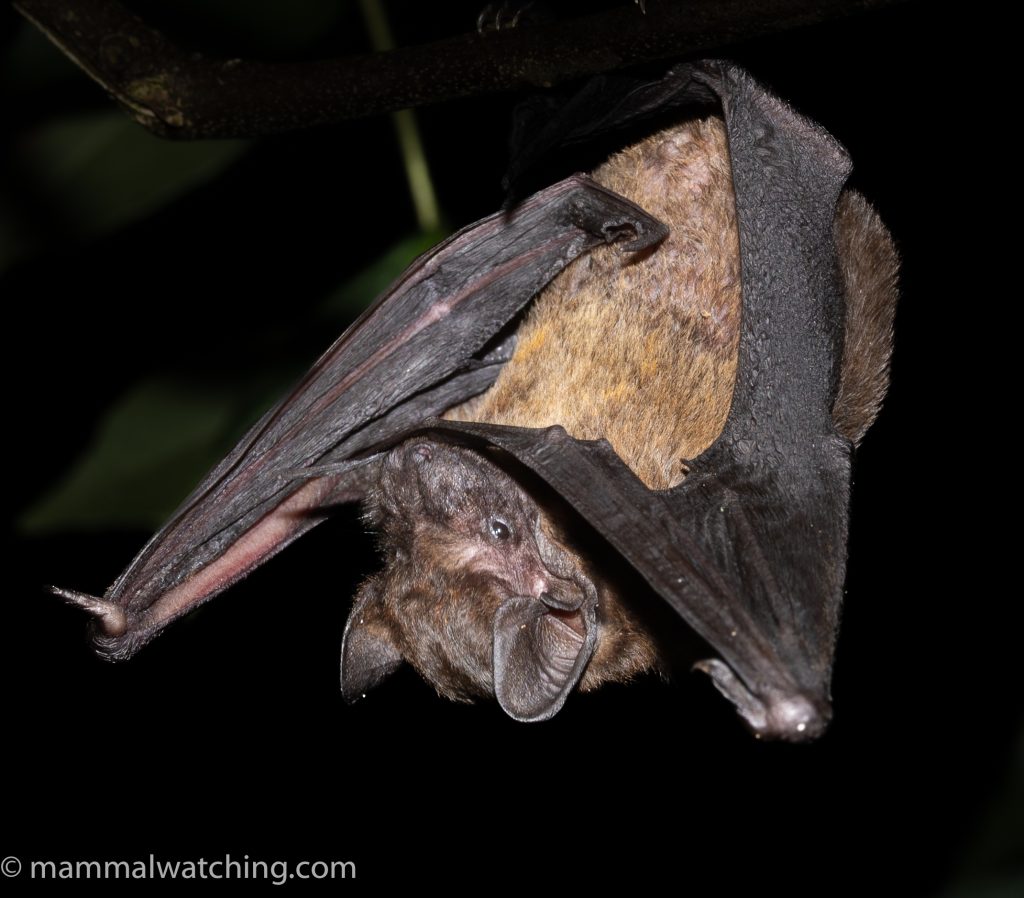
Doria’s False Serotine (Hesperoptenus cf. doriae), possibly
But Doria’s is a rarely caught species. I consulted bat experts Charles Francis and Juliana Senawi to see what they thought. Both thought it was a hesperoptenus. Charles had never seen Doria’s but the only picture he could find was of a rather differently coloured bat. Juliana suggested that doriae was the best option among those she could think of though wasn’t sure it is that either. I will keep investigating but record if for now as this species. Hopefully someone more expert than me will catch another one.
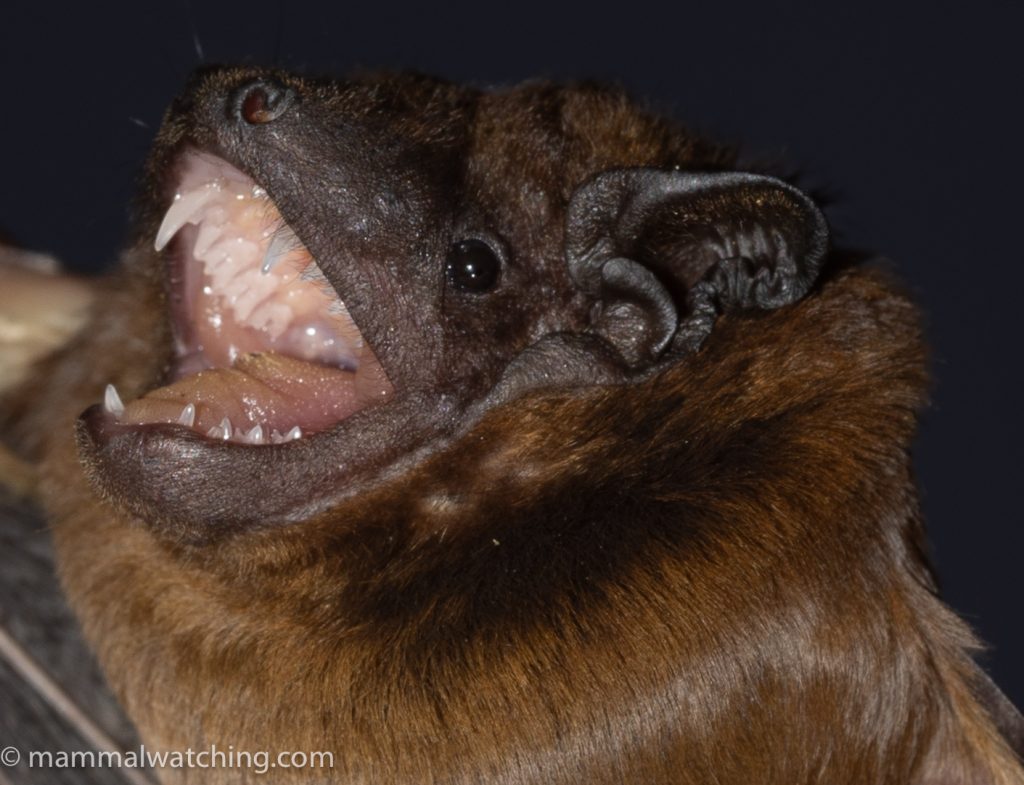
Doria’s False Serotine (Hesperoptenus cf. doriae), possibly. Photo Patrick Hall
I am including several pictures here in case someone has other ideas.
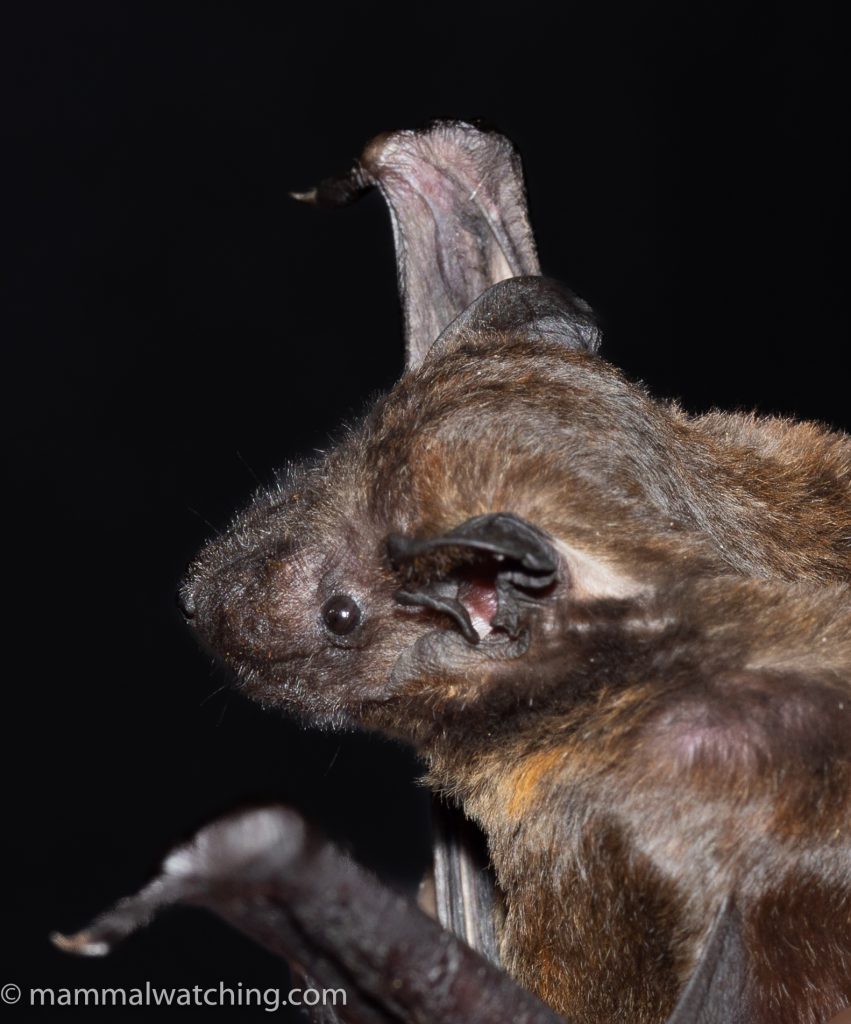
Doria’s False Serotine (Hesperoptenus cf. doriae) possibly
We also caught a brightly coloured pipistrelle with fur that was reddish right to the roots and again with a 39mm forearm.

Narrow-winged Pipistrelle (Pipistrellus stenopterus)
Charles Francis thought at first it might be a Narrow-winged Pipistrelle.
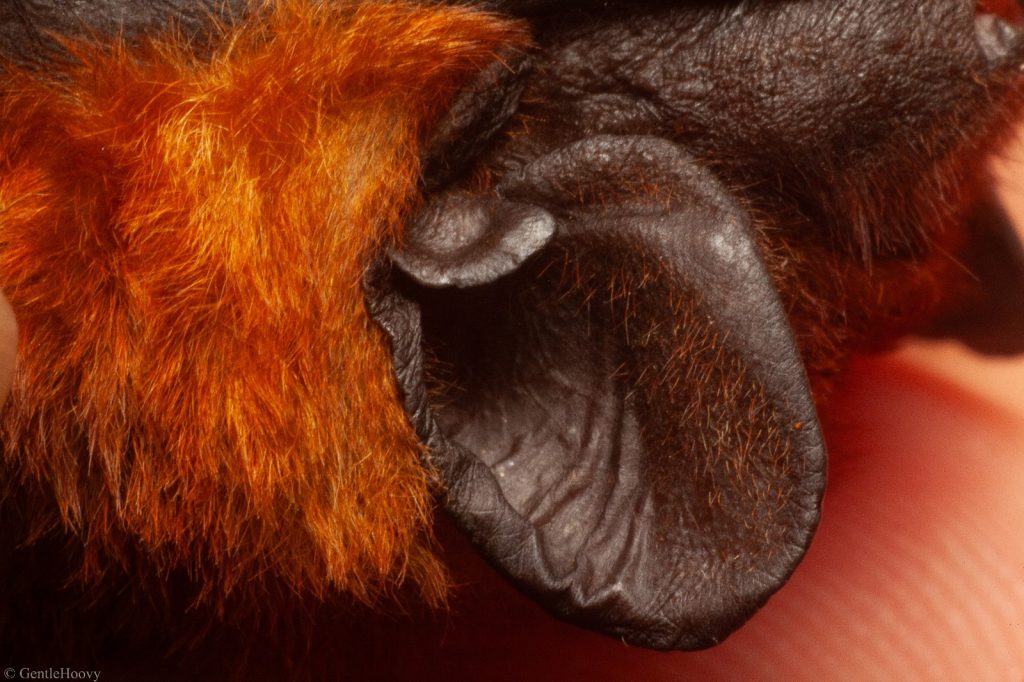
Narrow-winged Pipistrelle (Pipistrellus stenopterus)
But it wasn’t clear from the picture of the wing (below) whether the bone structure of the bat’s fingers match this species. Narrow-winged Pipistrelles have 5th fingers considerably shorter than their 4th fingers when compared to the ratio in other species.
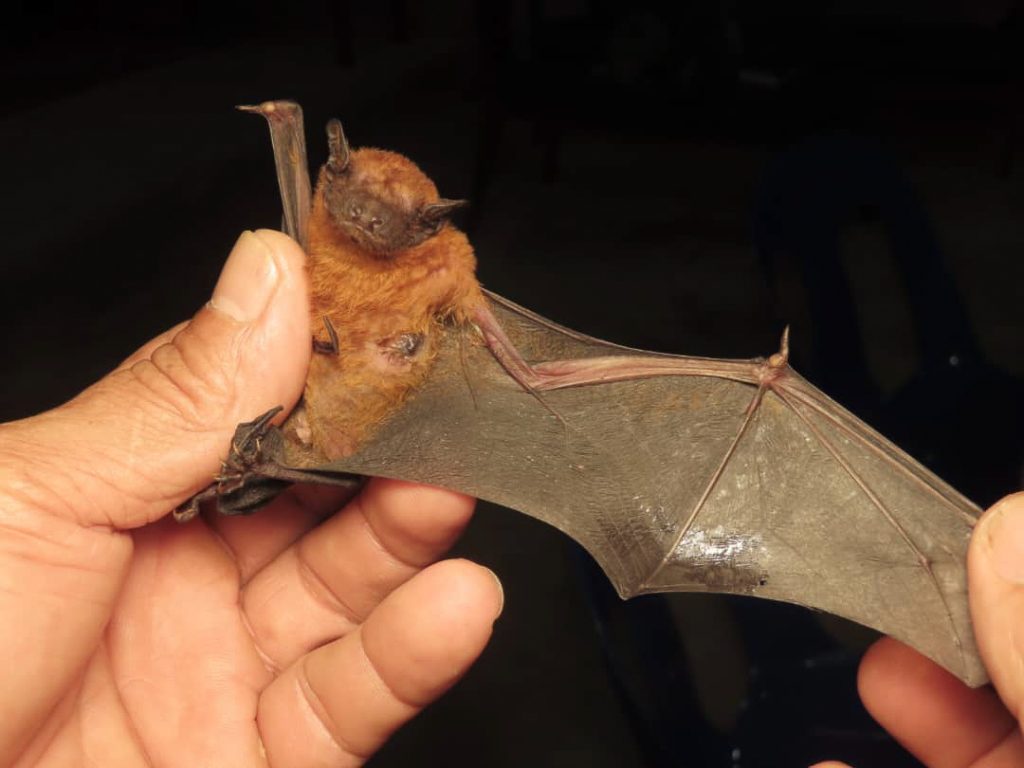
Narrow-winged Pipistrelle (Pipistrellus stenopterus)
But otherwise – to me at least – it looks very like this species so I record it as Pipistrellus stenopterus for the moment. If anyone has other ideas please let me know.
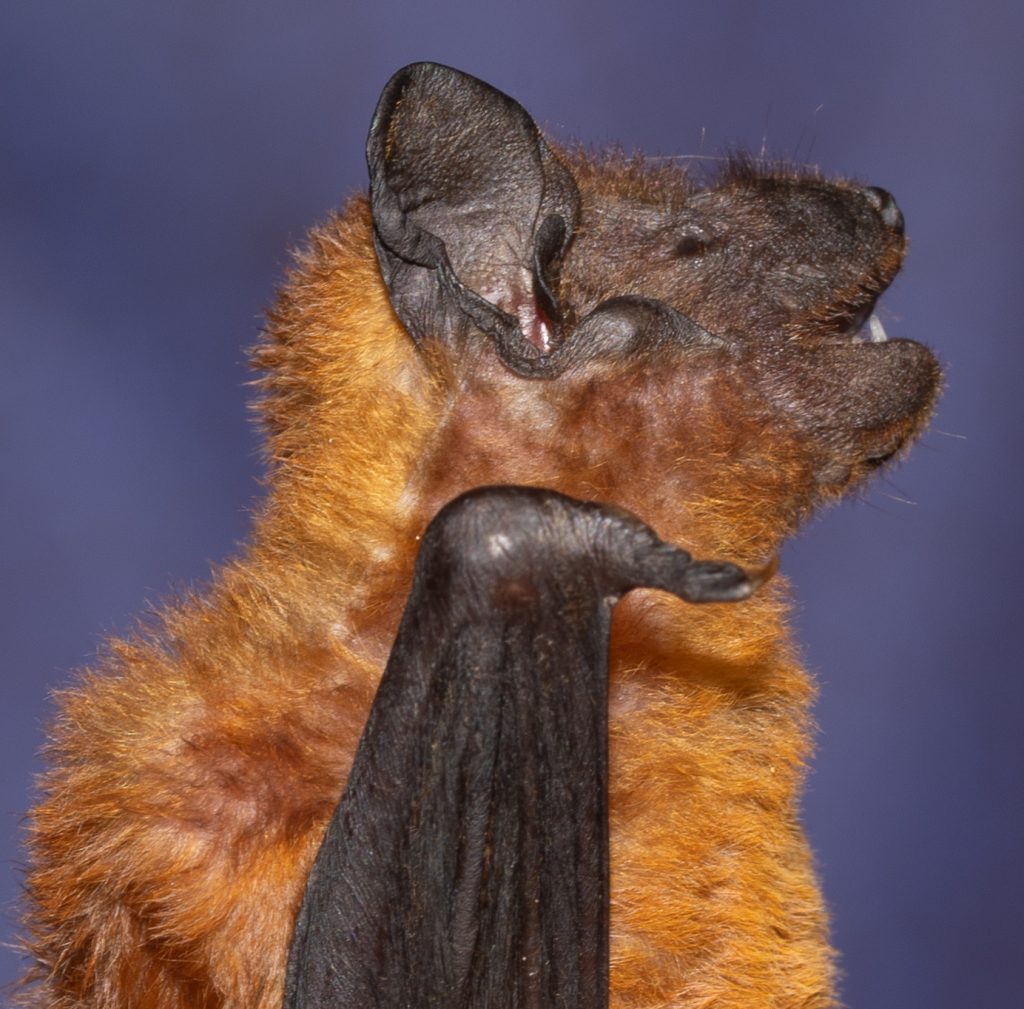
Narrow-winged Pipistrelle (Pipistrellus stenopterus)
If you are visiting Sayap and hope to see some bats be sure to let 1Stop Borneo know.
Beluran Safari
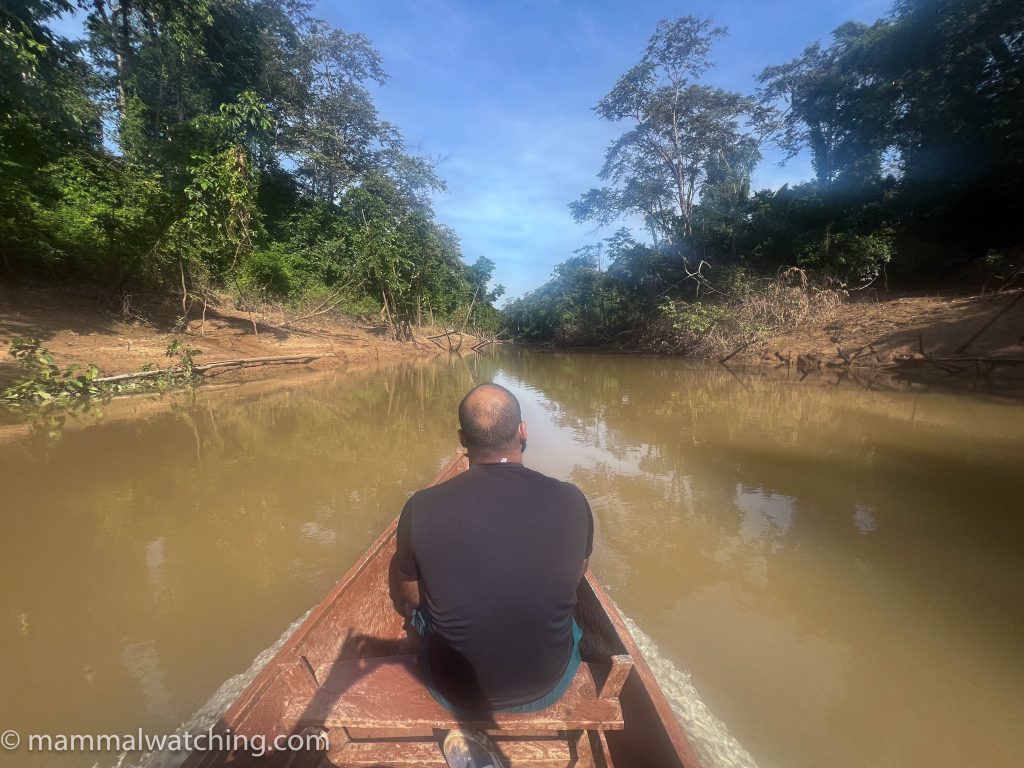
Beluran Safari is a private forestry concession that opened to tourism only this year, partly thanks to Shavez’s powers of persuasion. Beluran is a part of the same forest chunk as Deramakot and at the moment 1Stop Borneo are the only operator bringing tourists here. The logging company that manage Beluran want to harvest timber sustainably, protect wildlife and make additional income from tourism. I talked to the manager who seemed keen to adopt good practices and learn from other similar set-ups: for instance, Shavez is encouraging them to leave fruit-bearing trees standing.
The place reminded me very much of Deramakot when I first visited in 2015. Simple accommodation with AC and good food from the kitchen at the company office. The park is only 90 minutes from Sandakan airport and there is a long dirt road – longer than in Deramakot – that we could drive to our hearts’ content.
They also offer boat trips along the river from next to the accommodation. The water was extremely low when we were there which made navigation difficult.1Stop Borneo have already seen Flat-headed Cats twice along here during the handful of trips they have run to the park.
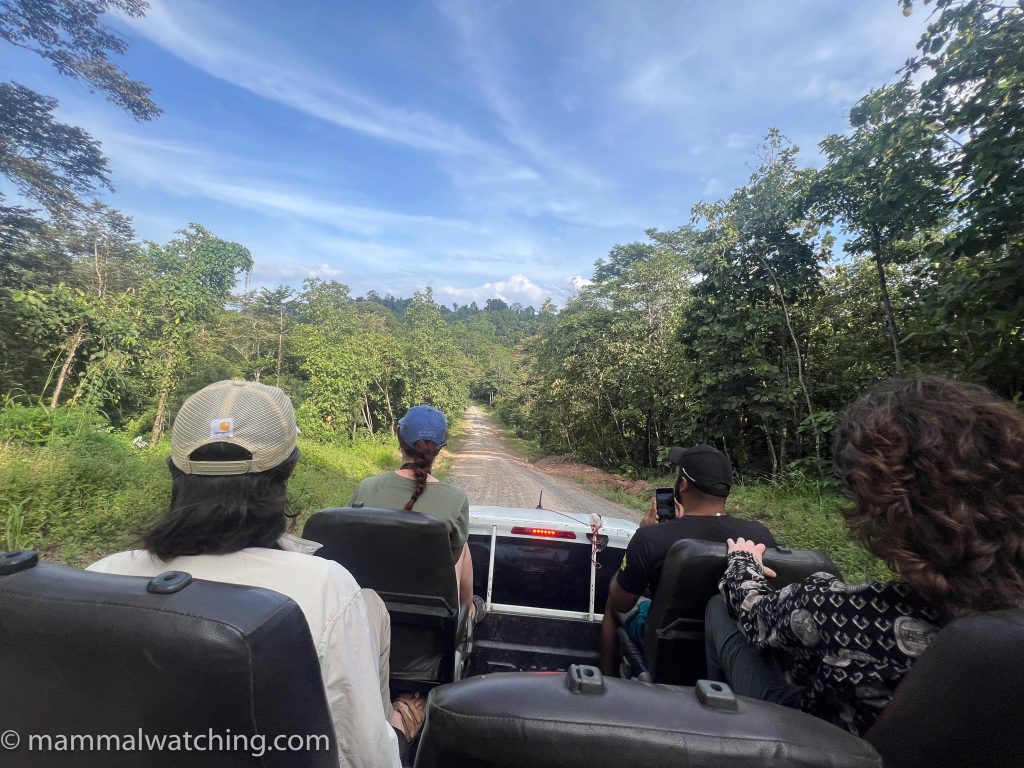
We spent two nights here, taking long night drives and one afternoon drive. As with so much of the forest in this part of Sabah, I believe your chances of bumping into something mega – Clouded Leopard, Marbled Cat, Sun Bear and more – is primarily a function of the effort you spend looking rather than the location. Anything could cross the road in front of you here. Indeed, in seven trips this year 1Stop Borneo have seen two Clouded Leopards, two Flat-headed Cats, two Marbled Cats, a Sun Bear and more.
The afternoon drive was quiet with a Yellow Muntjak the highlight. A short morning boat cruise produced many Long-tailed Macaques, a few Maroon Langurs plus a Prevost’s Squirrel. We just missed an Orangutan, which only I saw (and only in my thermal scope). Shavez and I tried for an hour along the river at night for Flat-headed Cat without luck. The only mammal that evening was a Sambar.
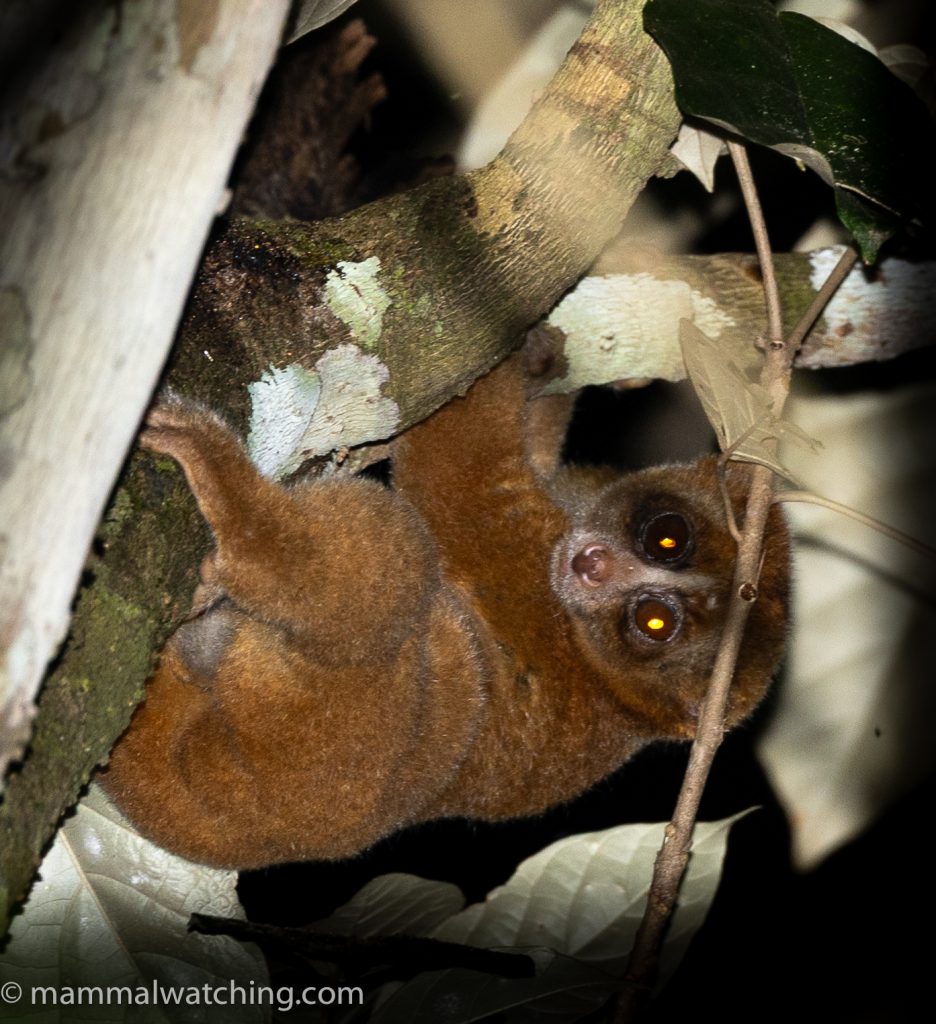
Philippine Slow Loris (Nycticebus menagensis)
We had a nice selection of species on both night drives.
A Philippine Slow Loris was the first mammal of the first evening, closely followed by Sambar and Greater Mouse Deer.
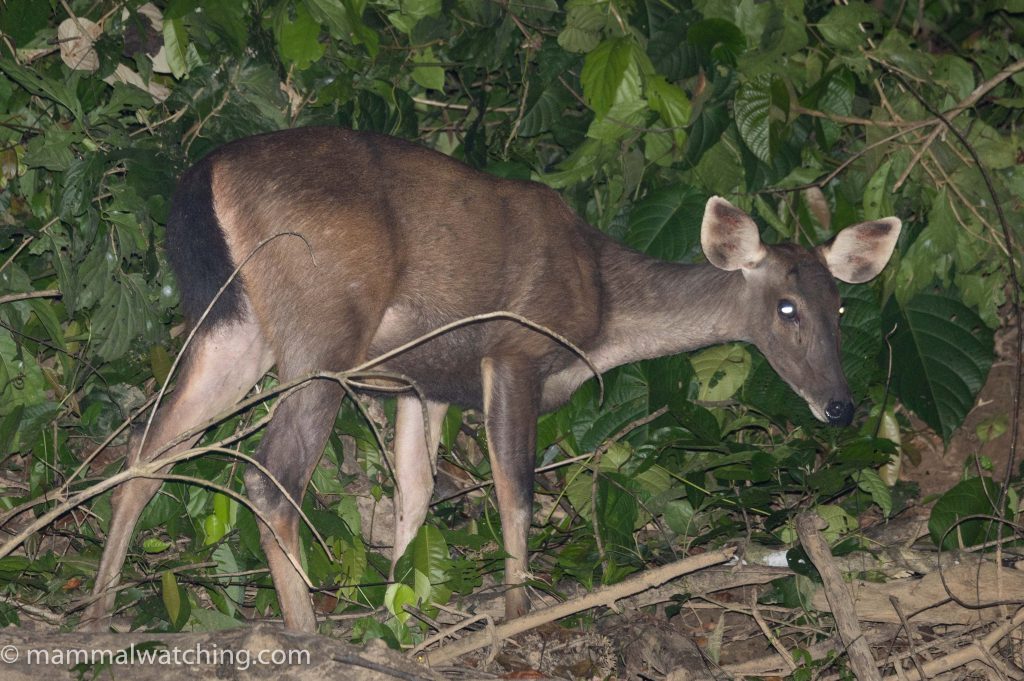
Sambar (Rusa unicolor)
Flying squirrels were not as common as in Deramakot, perhaps because there are fewer very large trees: we saw only two or three Thomas’s Flying Squirrels, one or two Red Giant Flying Squirrels and a rarer Black Flying Squirrel.
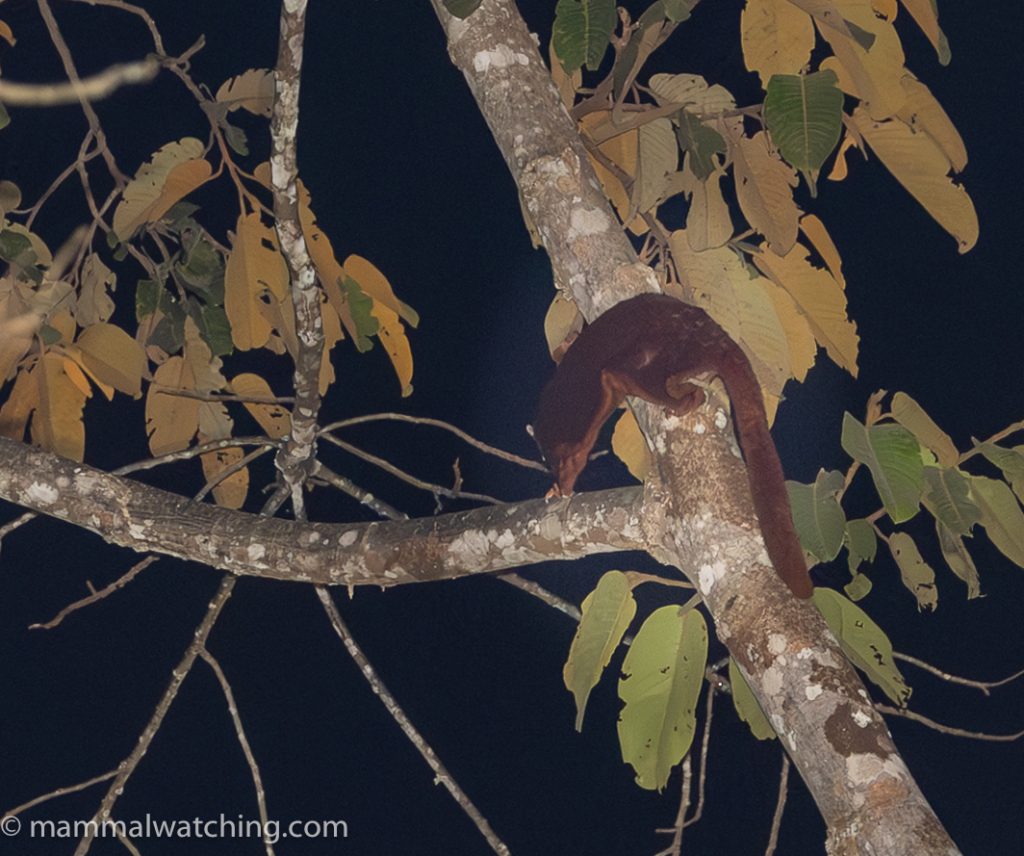
Thomas’s Flying Squirrel (Petaurista thomasi)
I was surprised that we didn’t see any Colugos.
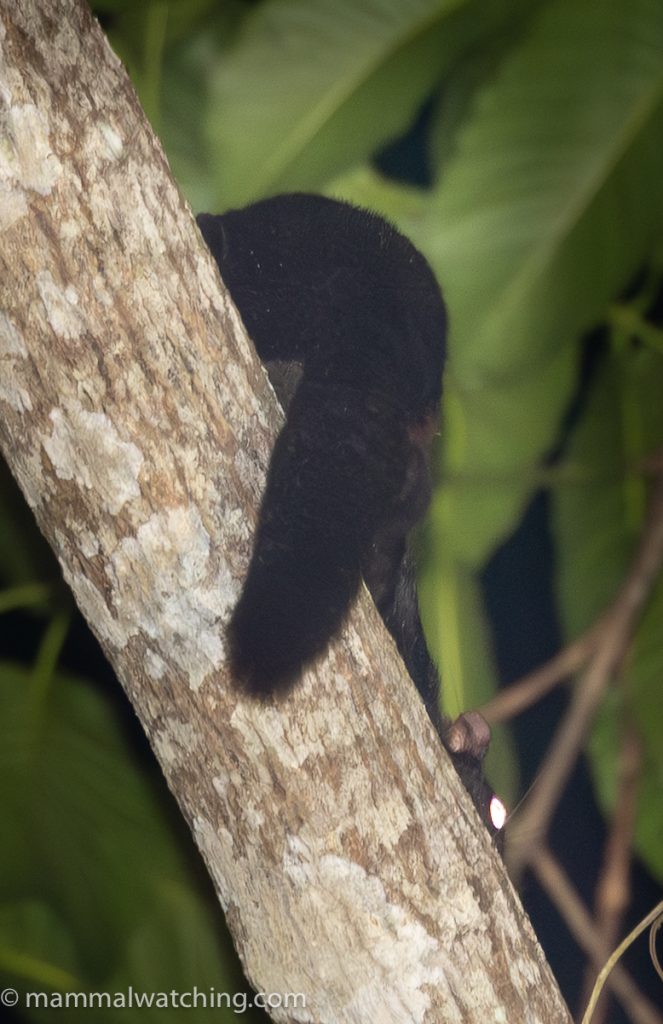
Black Flying Squirrel (Aeromys tephromelas)
The only bats I could identify were a few Large Flying Foxes on a fruiting tree.
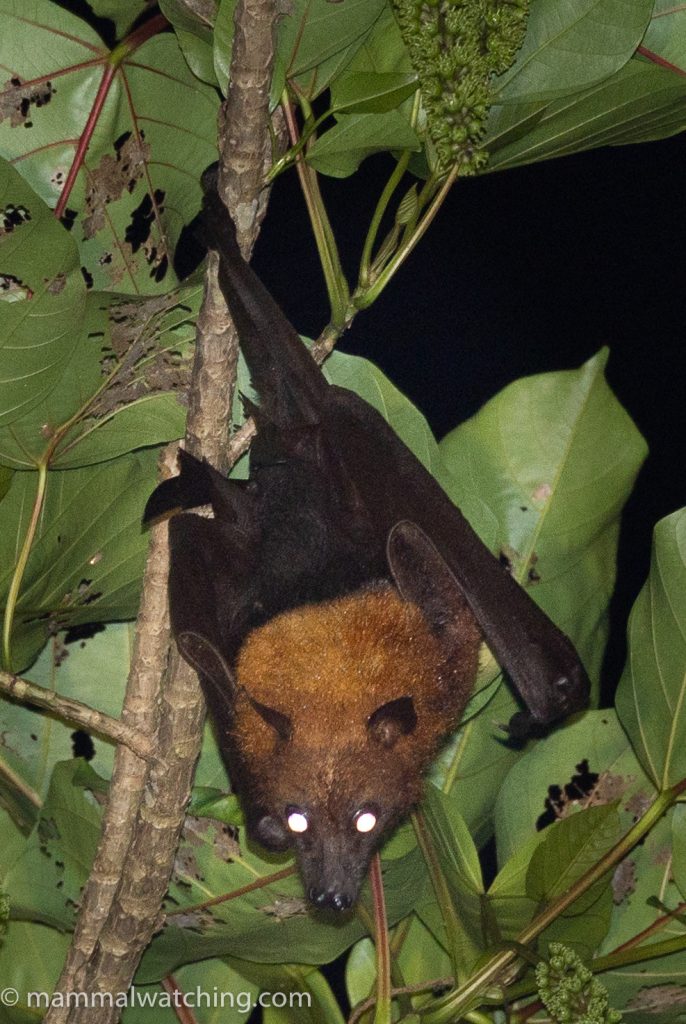
Large Flying Fox (Pteropus vampyrus)
Small-toothed and Philippine Palm Civets were common.
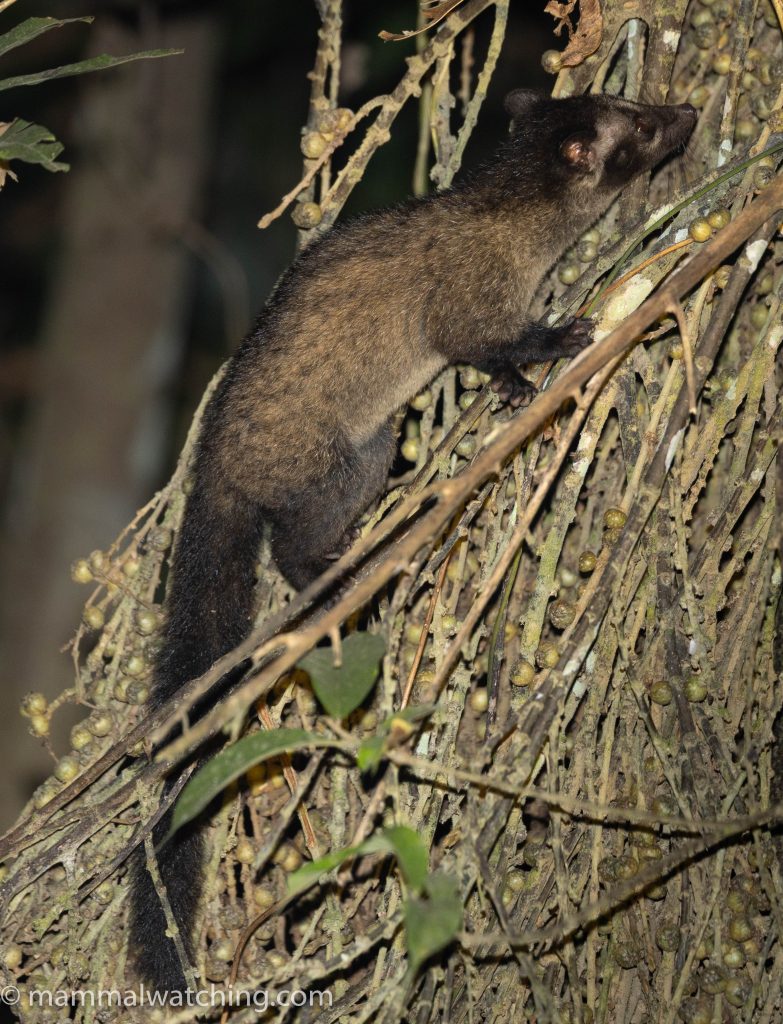
Small-toothed Palm Civet (Paradoxurus (stigmatica) trivirgata )
The other carnivores include a Banded Palm Civet, several Malay Civets and a Leopard Cat on both nights.
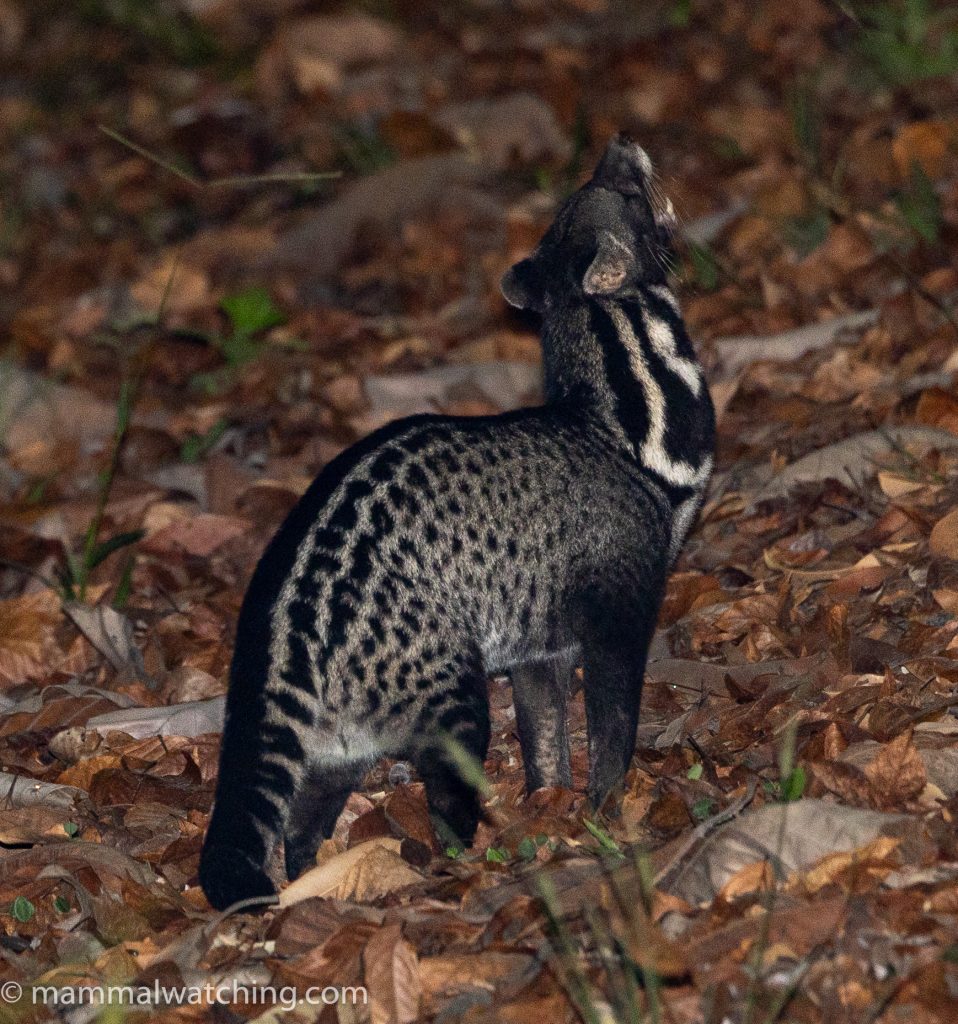
Malay Civet (Viverra tangalunga)
Two separate Sunda Stink Badgers, such great little beasts, were fun to watch.
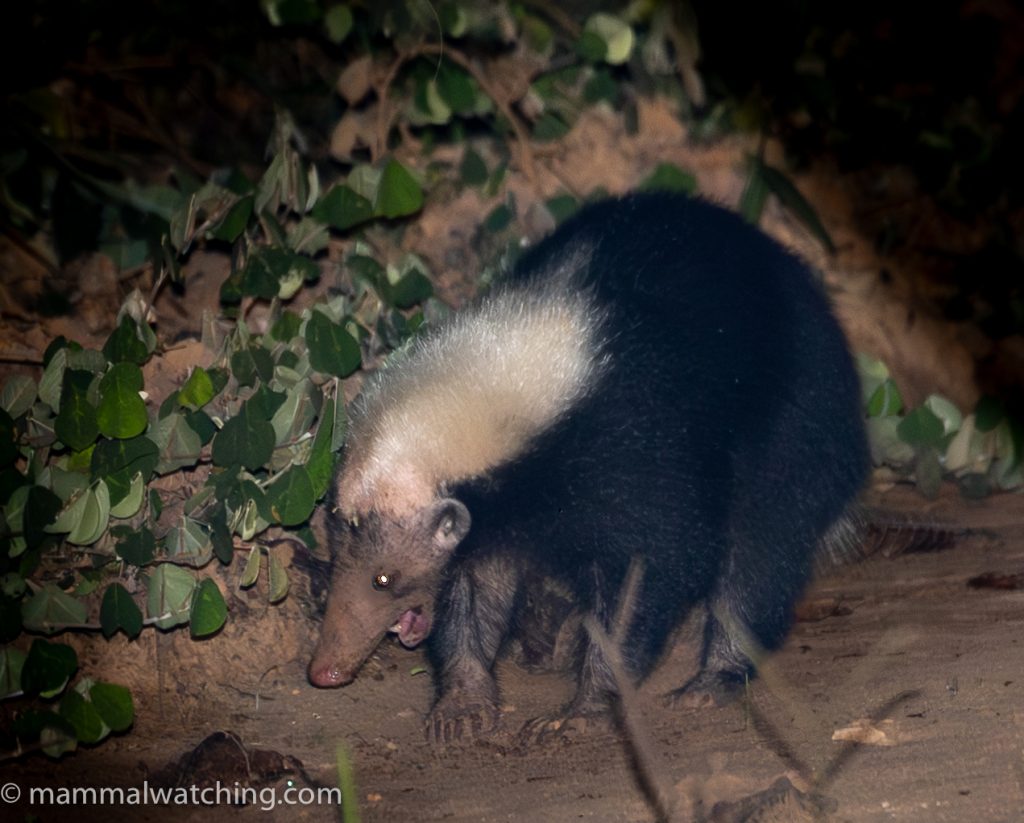
Sunda Stink Badger (Mydaus javanensis)
But best of all was my first Western Tarsier, which Kylie spotted. Kylie, though not a blood relative, is now my favourite child.

Western Tarsier (Cephalopachus bancanus)
I may well be the only mammalwatcher to have taken four trips to Borneo without seeing a tarsier. If you are struggling like me then I hadn’t realised – until the mammalwatching workshop – quite how common they are at the Rainforest Discovery Centre where they seem guaranteed. Nor had I realised how popular their night walks are: 70,000 people joined their spotlight walks in 2024 alone! Thinking about it, I am probably the only person to have visited Borneo four times without having seen a tarsier.
No longer! This sighting made up for it and we had a long encounter with this animal while trying our best not to shine light – or flash – into its eyes.
Gomantong Caves
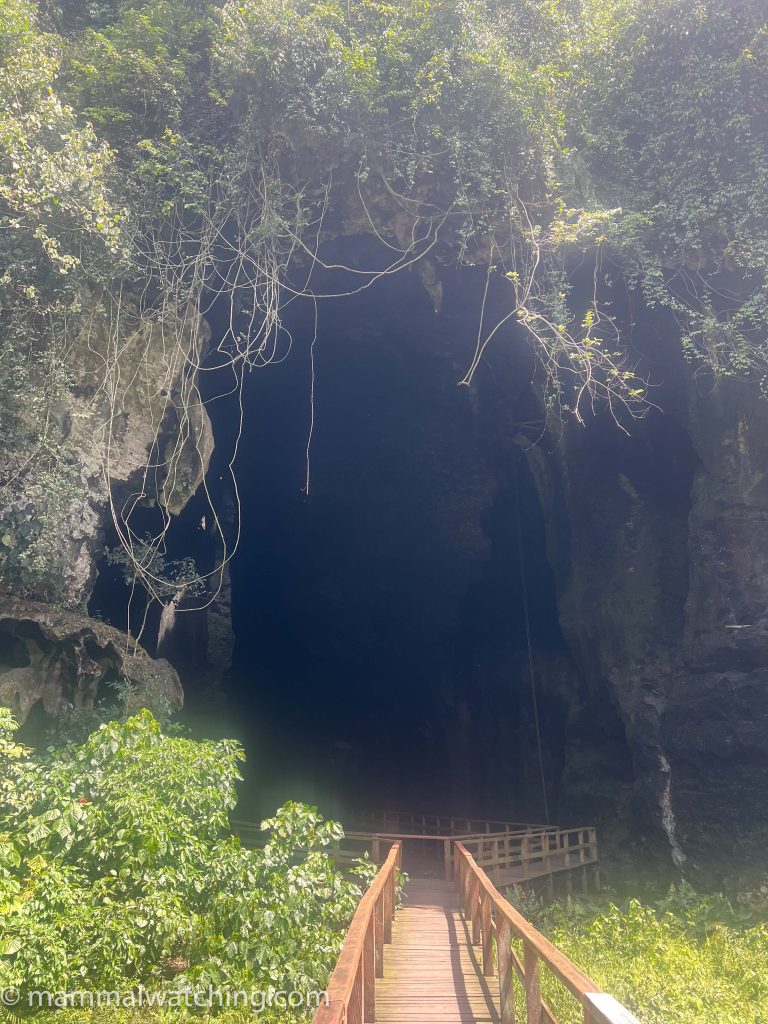
We left Beluran to spend the next night on the Kinabatangan River, stopping for an hour at Gomantong Caves en route. The area around the caves are – according to Mike Gordon – one of the most reliable places to see Orangutan and sure enough we found a mother and infant near the car park, though our views, and my photos, were not good. The Maroon Langurs along the boardwalk into the caves were more obliging.
I hadn’t been to the caves since 2008 and was interested in trying to get better looks – and better photos – of the bats inside. According to this paper 25 species have been recorded here. Most of the bats were still too high to see or photograph well, even with my better equipment, but we did record five species.

Little Long-fingered Bat (Miniopterus australis)
A few scattered bentwing bats were so small that they had to be Little Bentwings.
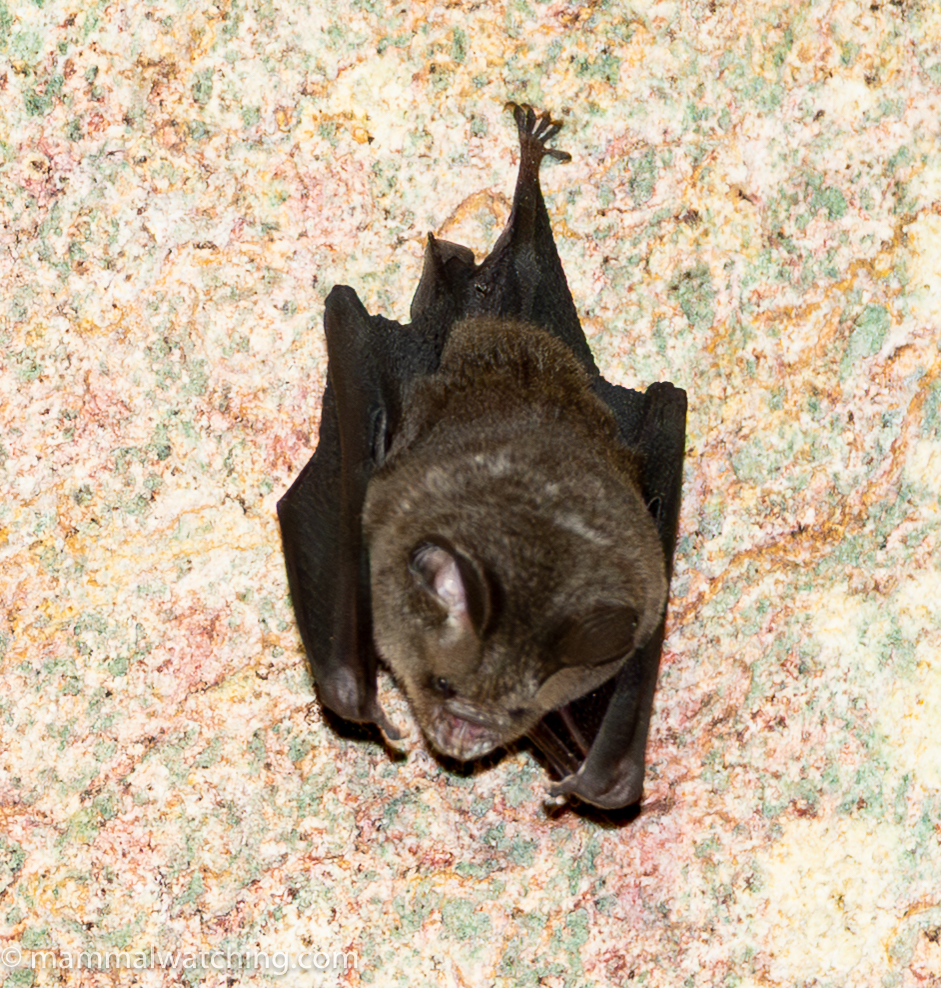
Fawn-colored Leaf-nosed Bat (Hipposideros cervinus)
I saw many smaller roundleaf bats. All of those I photographed appeared to be Fawn-colored Leaf-nosed Bat, one of commonest species in the cave.

Diadem Leaf-nosed Bat (Hipposideros diadema)
Groups of much larger bats, with distinctive pale patches on their fur, were easier to ID: Diadem Leaf-nosed Bats.
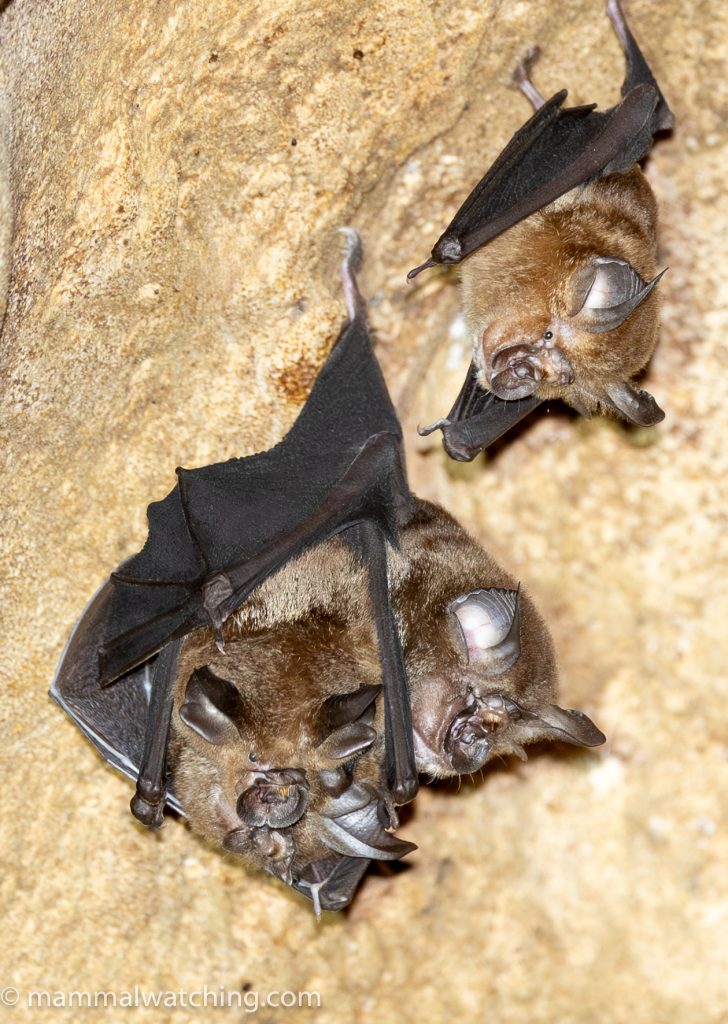
Creagh’s Horseshoe Bat (Rhinolophus creaghi)
The common horseshoe bat in the cave is Creagh’s Horseshoe Bat, which are also fairly easy to identify if you can see them well: they have a tuft of hair in the middle of their noseleaves.
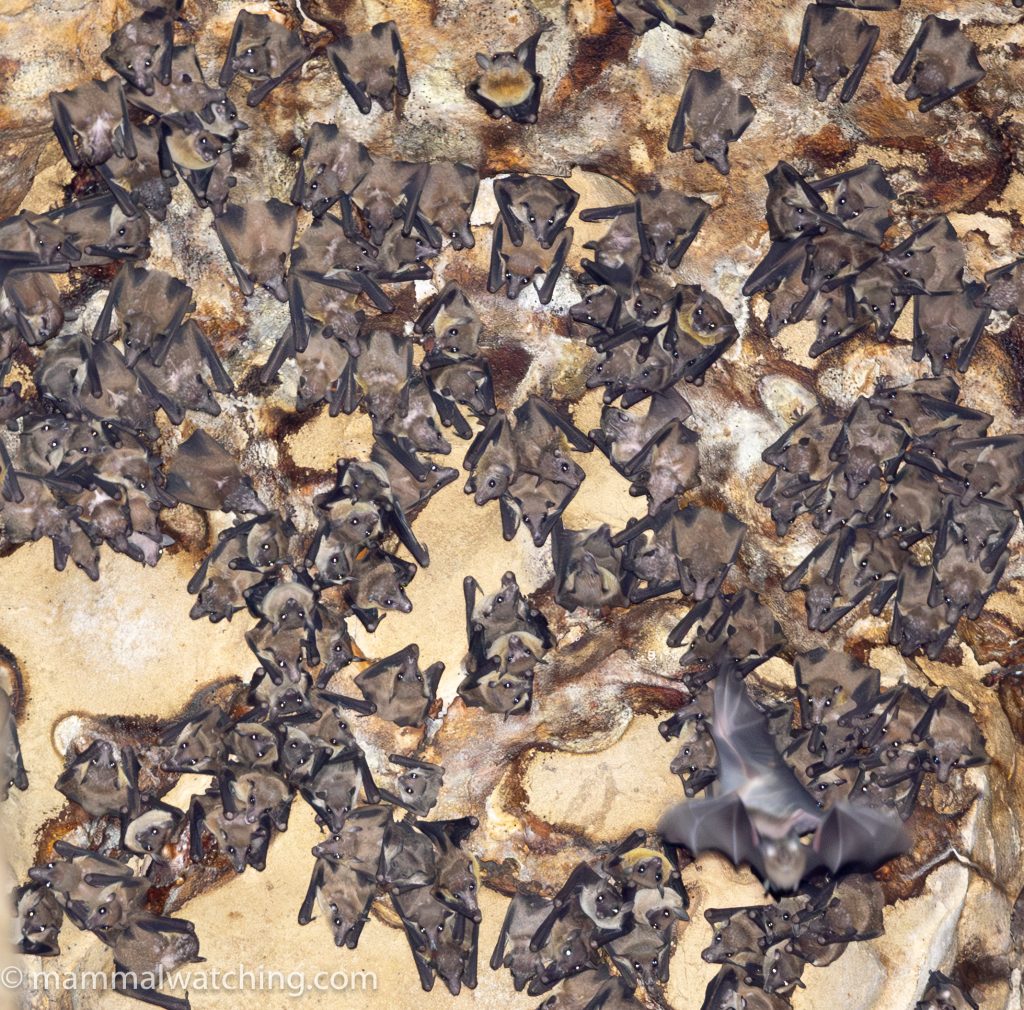
Lesser Dawn Bat (Eonycteris spelaea)
Walking back out of the cave you can find a colony of fruit bats high on the ceiling on the left hand side. Their eyeshine in a flashlight is obvious (so you know these are fruit bats). Photographs confirmed they are Lesser Dawn Bats aka Cave Nectar Bats.
The Kinabatangan River
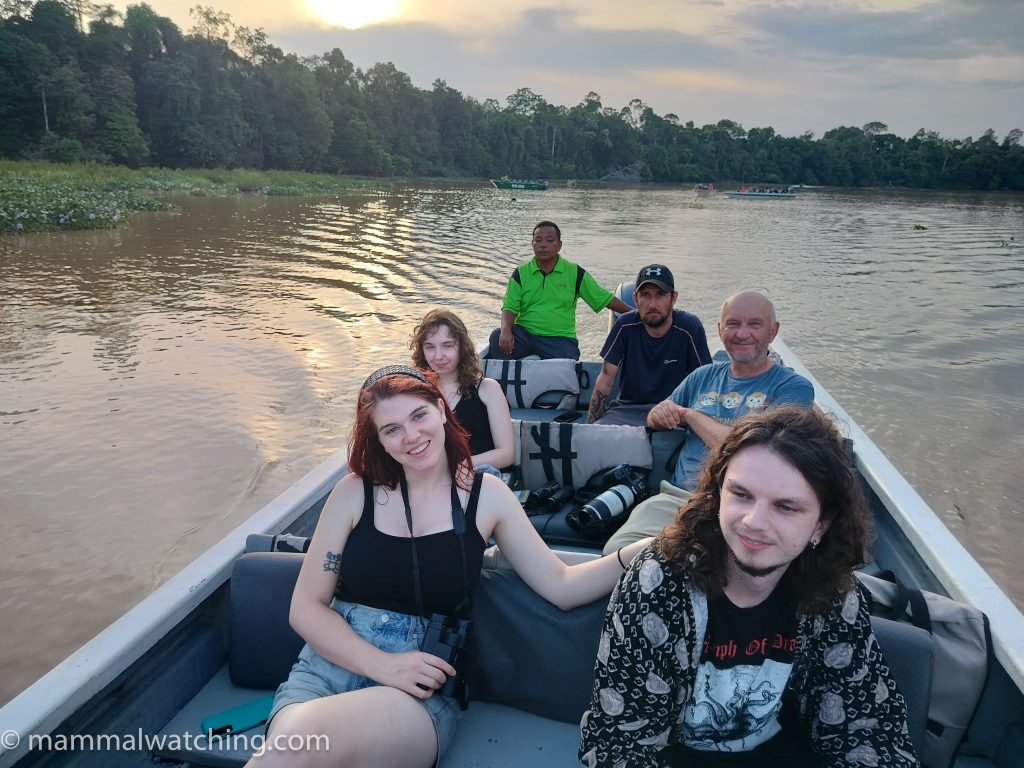
I promised the kids we would see Proboscis Monkeys, and so we spent a night on the Kinabatangan River, staying at the comfortable Borneo Nature Lodge. Our primary reason for choosing this lodge, among the many others, was because Bornean guiding legend Mike Gordon rates Janu, one of the boatman, as THE best guy on the river to find you a Flat-headed Cat. I always recommend doing what Mike tells me. So, if you book here then ask for Janu.
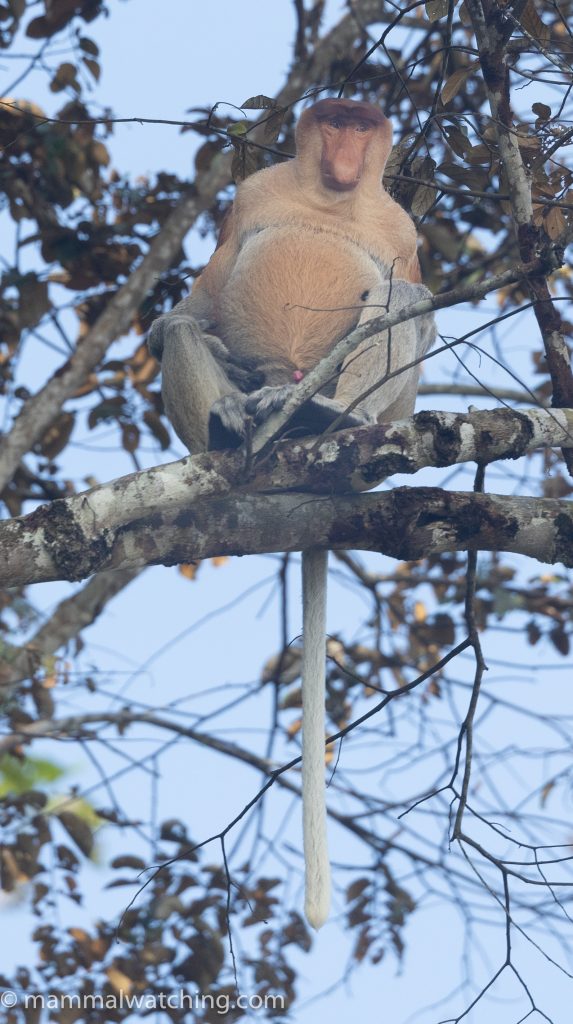
Proboscis Monkey (Nasalis larvatus)
We saw plenty of Proboscis Monkeys on our afternoon cruise, though we saw only the arm of an Orangutan emerging from its nest. But that was OK: Mike Gordon had spotted one five seconds after he strolled into the lodge restaurant to greet us earlier that afternoon.
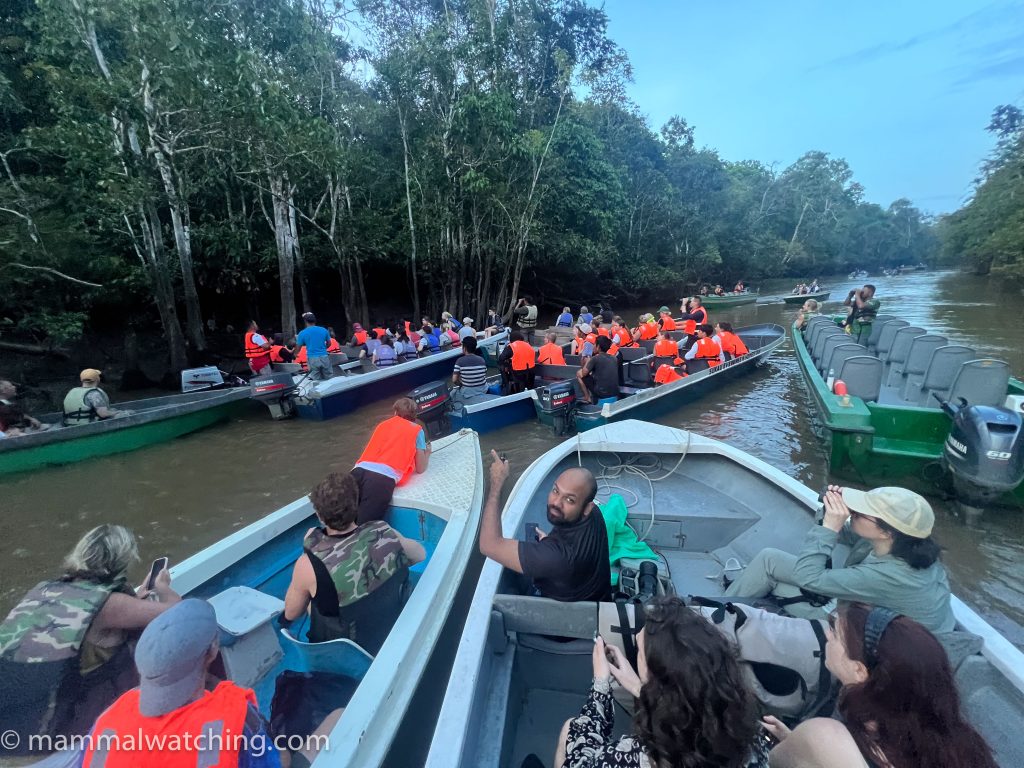
Elephant jam
I have not been on the Kinabatangan since 2008. I remember one or two boats on the river back then. The ecotourism industry has taken off and it’s a regular Masai Mara out there now. We didn’t get a glimpse of the Elephants that had been spotted walking along the river and all those boats (above) were searching for. The only other mammals that afternoon were hundreds of Pig-tailed and Long-tailed Macaques.
After dinner Mike Gordon, who had interrupted his holiday to spend the evening with us, casually lifted his phone and showed me a video of a Sunda Clouded Leopard strolling along a riverbank. I already posted at length about this incredibly lucky sighting: the story is here. In short, we dashed across the river and spent 90 minutes gawking at a male leopard in a tree just above us. We walked away.
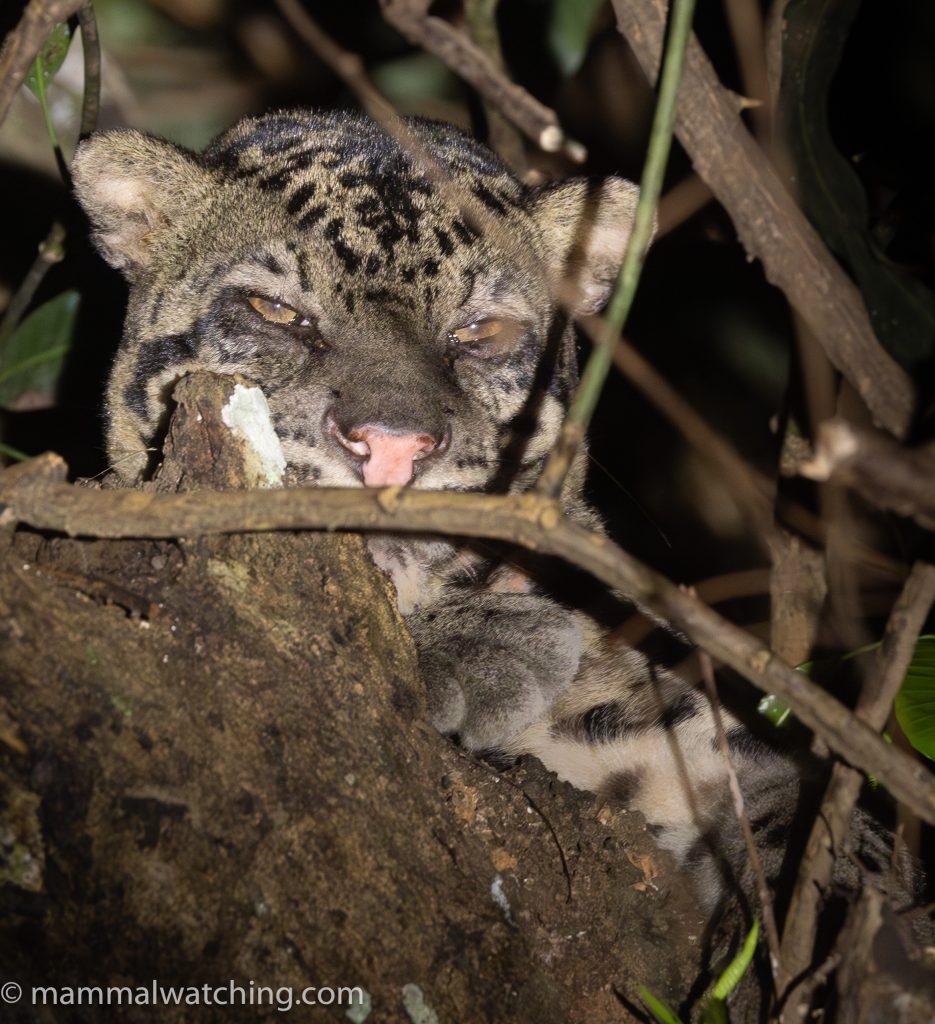
Sunda Clouded Leopard (Neofelis diardi)
The morning cruise the next day was uneventful other than a lone Elephant. We left for INIKEA, our next destination, after breakfast.
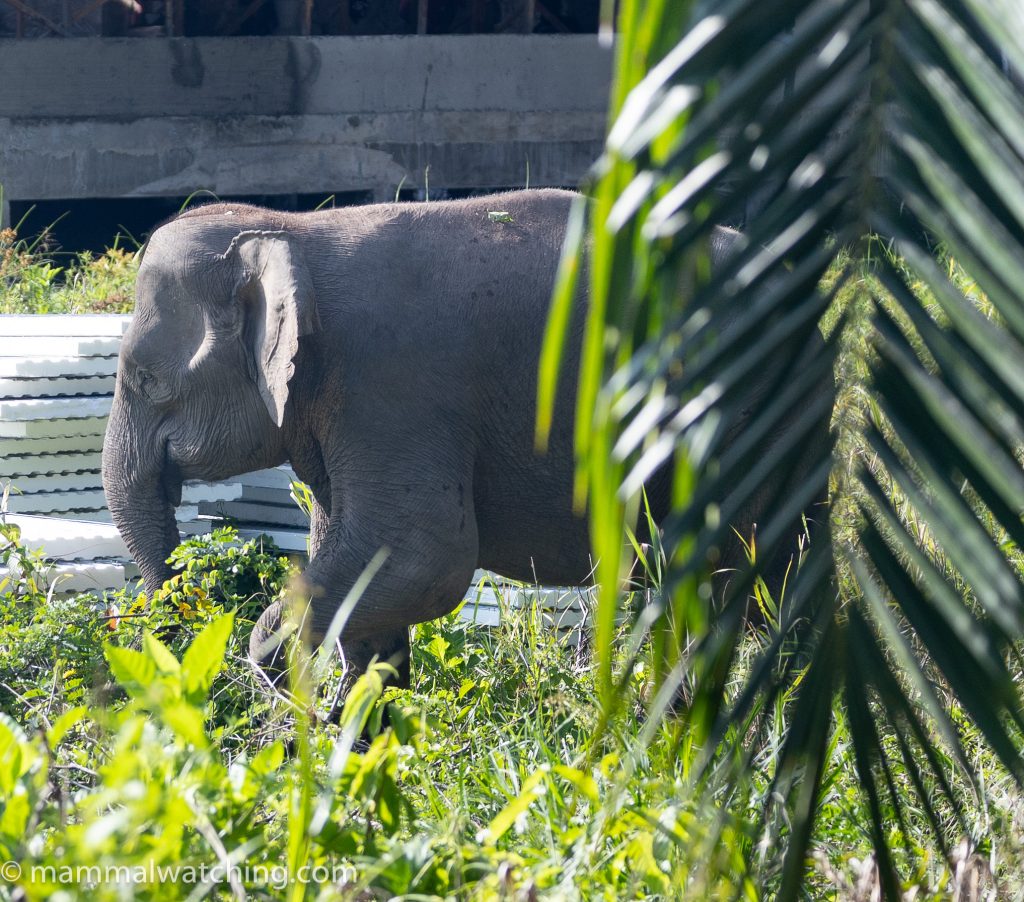
Asian Elephant (Elephas maximus)
Madai Caves
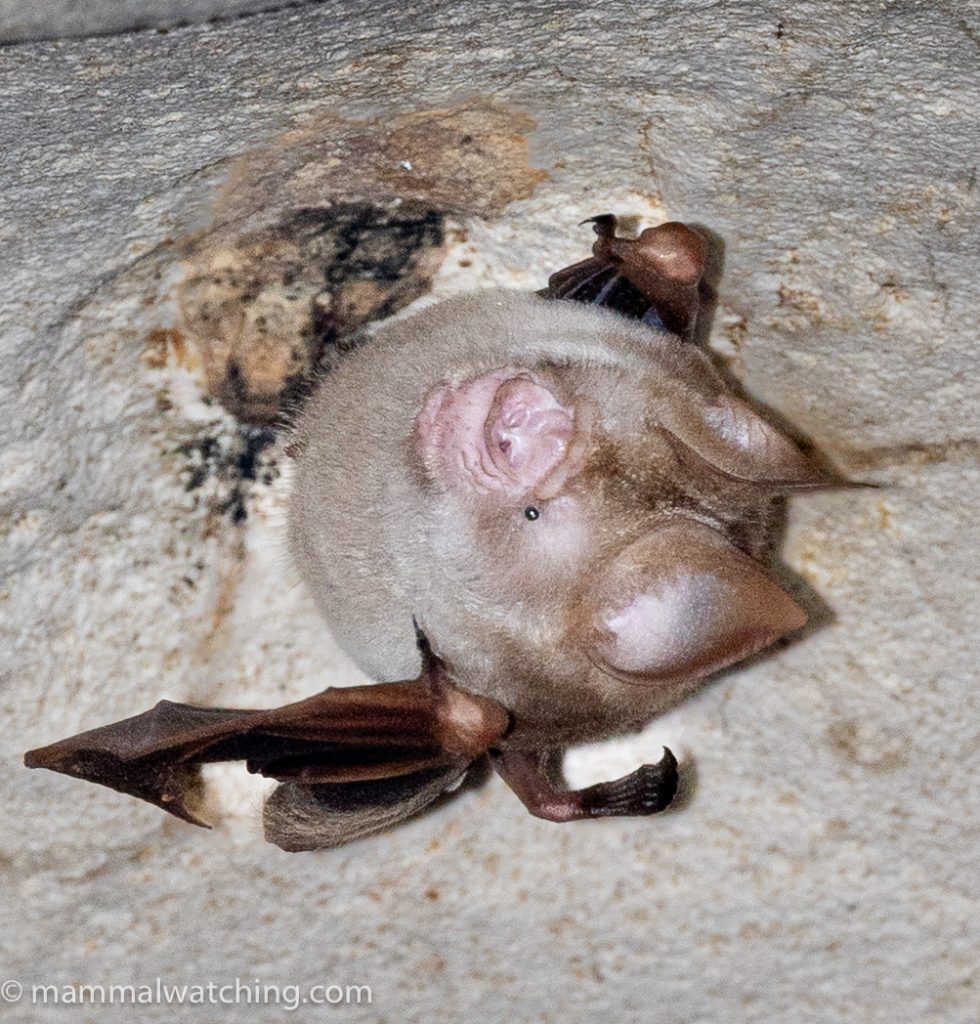
Diadem Leaf-nosed Bat (Hipposideros diadema)
Before we reached INIKEA, a 6 hour drive from the Kinabatangan, we dropped in at Madai Caves en-route. Madai caves are less impressive than Gomantong, but I thought they might be worth checking out in case we could find some different bats. According to this paper 30 species have been recorded in and around the caves, even more than in Gomantong.
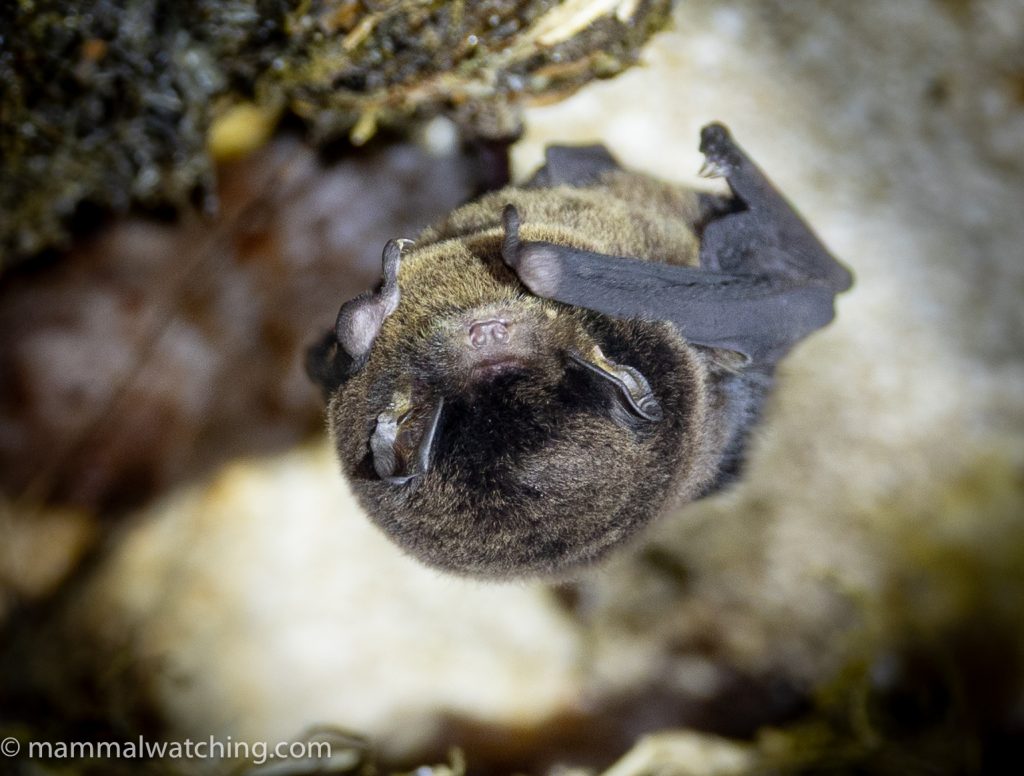
Little Long-fingered Bat (Miniopterus australis)
We saw four species, all of which we’d seen at Gomantong, though views of some species here, such as the Little Bentwing Bats were closer.
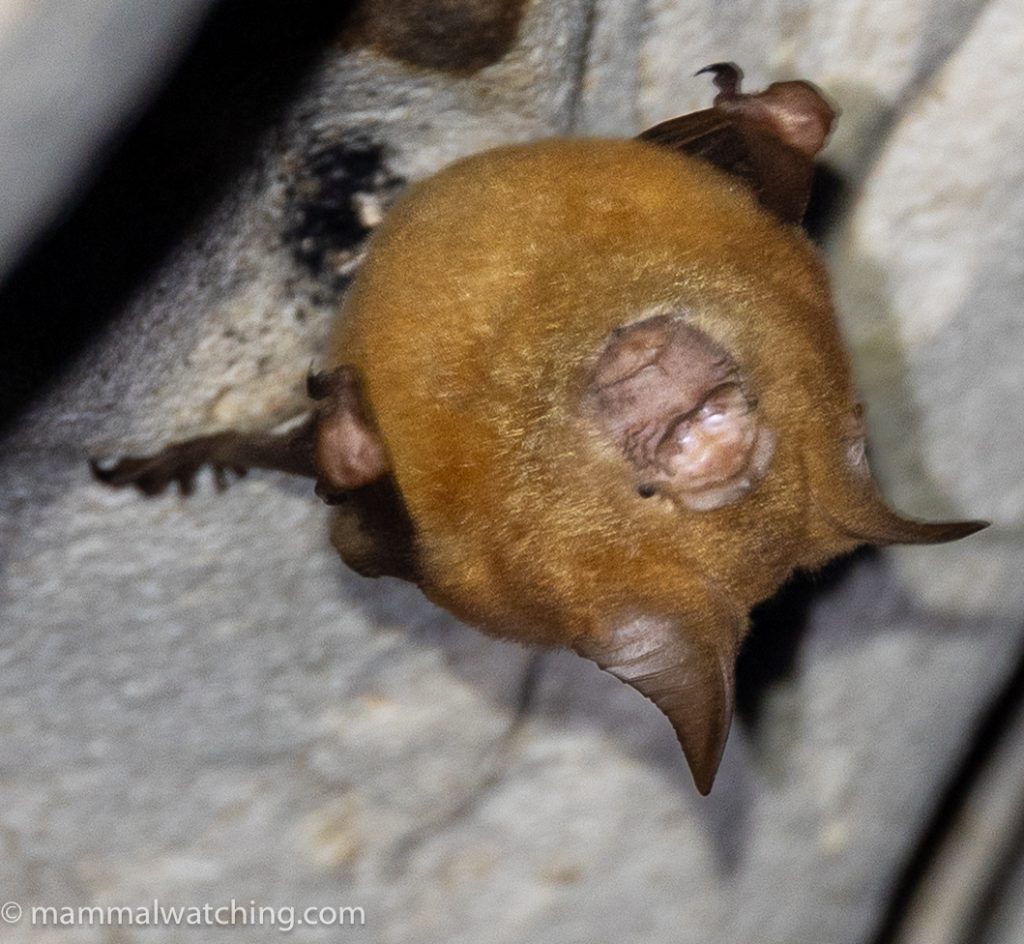
Diadem Leaf-nosed Bat (Hipposideros diadema), orange morph
The Diadem Roundleaf Bats were also closer and were available in two colours.
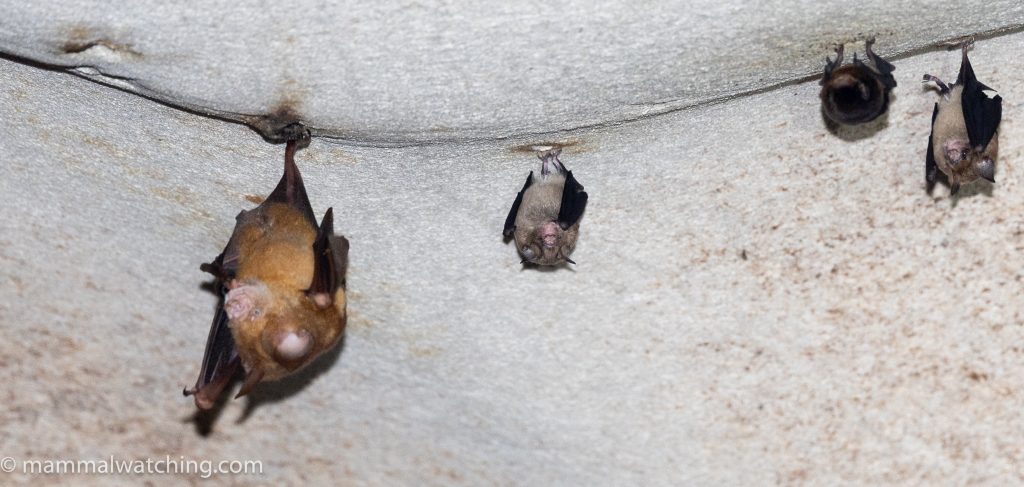
Diadem Roundleaf Bat, Fawn Roundleaf Bat and Little Bentwing Bat
Smallish roundleaf bats looked very like Fawn-colored Leaf-nosed Bats, with the photo (above) of the bats next to the Diadem Roundleaf and Little Bentwings helping to confirm that ID.
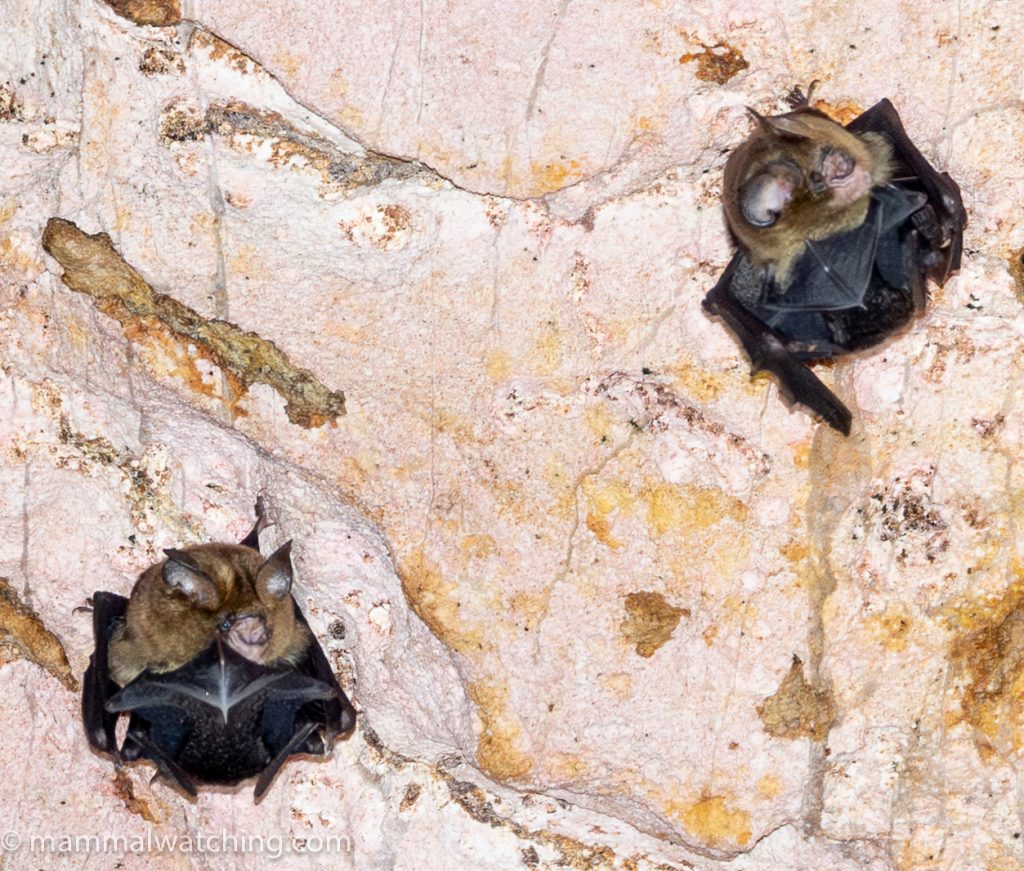
Fawn-colored Leaf-nosed Bat (Hipposideros cervinus)
And more Creagh’s Horseshoe Bats.
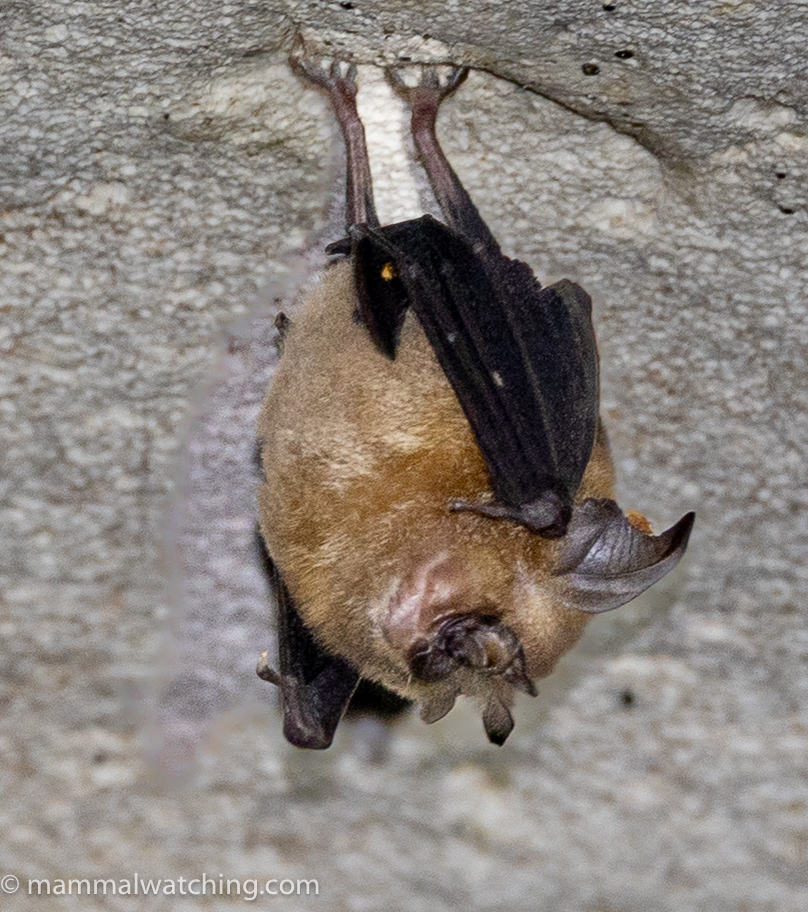
Creagh’s Horseshoe Bat (Rhinolophus creaghi)
Shavez had warned me he didn’t really like visiting the caves as they are littered with trash. He was right. Bottom line – to borrow from Samuel Johnson – ‘worth seeing but not worth going to see’.
INIKEA
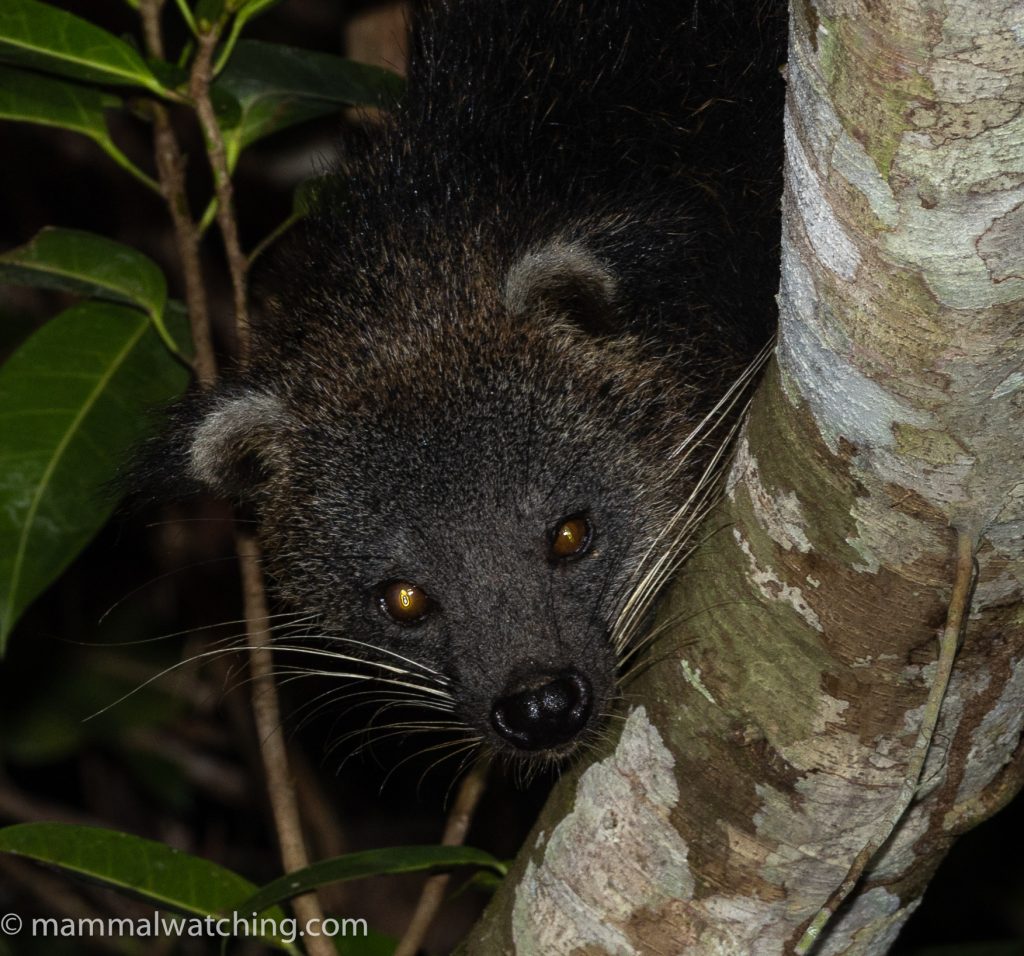
Binturong (Arctictis binturong)
Our one night at INIKEA – which is a 6 hour drive from Sukau in the Kinabatangan – did not do justice to the place. This is a large – 18,500 ha – slab of forest that was ravaged by wildfires in the early 1980s after a severe El Niño. The forest has been rehabilitated with the help of funding from the owners of IKEA and driving through the reserve it is difficult to imagine it was devastated by fire so recently.
The accommodation here is simple: dorm-style beds in a covered, but open sided, structure, with communal bathrooms. We enjoyed our night here.
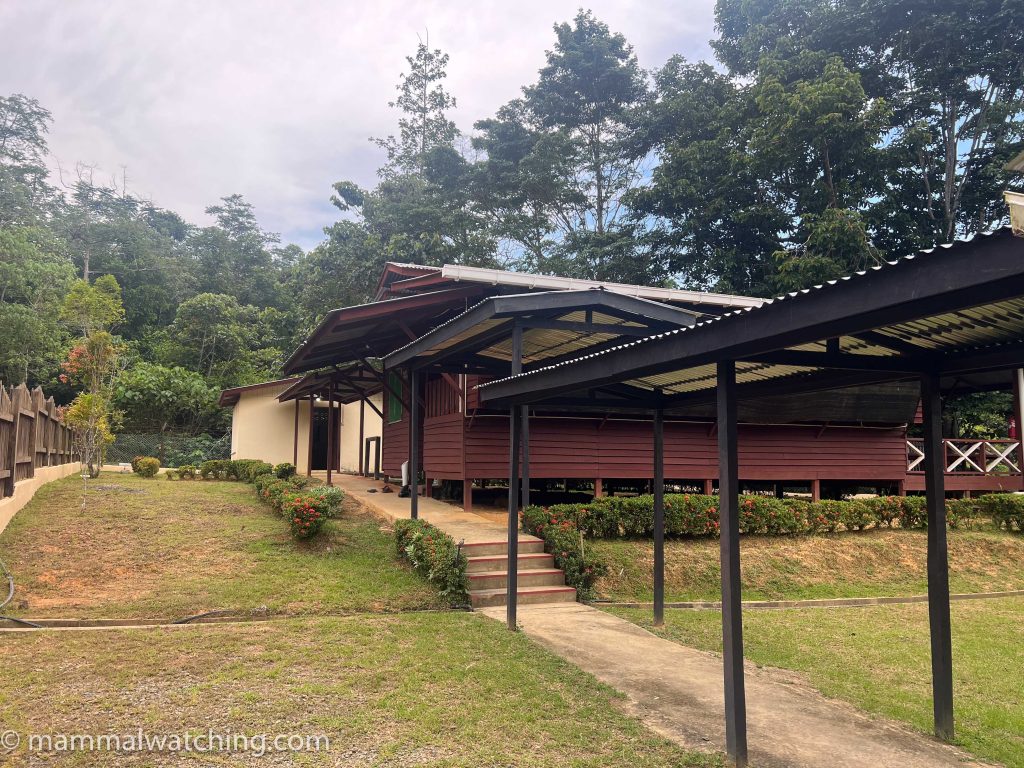
Once again this feels like a place where you could bump into a mega-mammal at any moment. We took a four hour night drive and were out again for a couple of hours the following morning.
The mammalian highlights were another Western Tarsier, a Sunda Stink Badger and a Binturong almost at eye level.

Small-toothed Palm Civet (Paradoxurus trivirgata)
We also saw Thomas’s Flying Squirrels, a Sunda Leopard Cat, Small-toothed and Philippine Palm Civets, a Malay Civet, Sambar Deer and Mouse Deer (probably both Greater and Lesser).
Tawau Hills
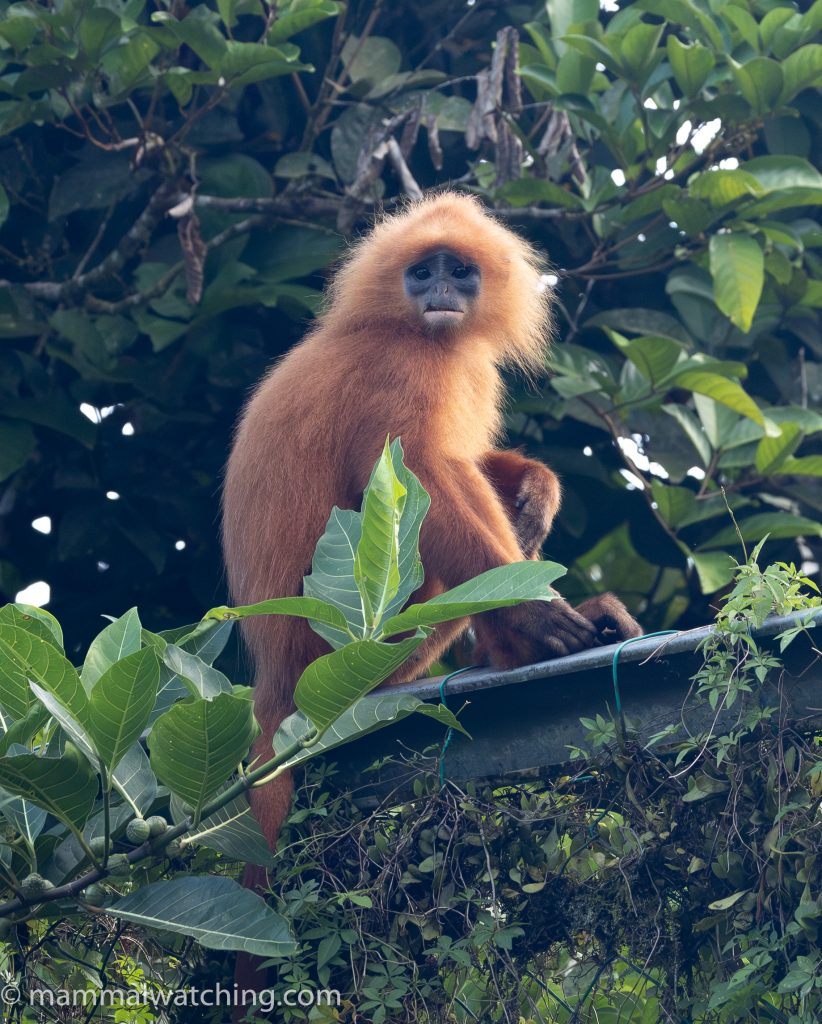
Maroon Langur (Presbytis rubicunda)
Shavez was not going to let me visit Sabah without taking me to see “his baby”, Tawau Hills Park. This is a lovely slab of primary rainforest, only an hour from Tawau Airport that 1Stop Borneo are working with to plant fig trees here and create wildlife corridors.
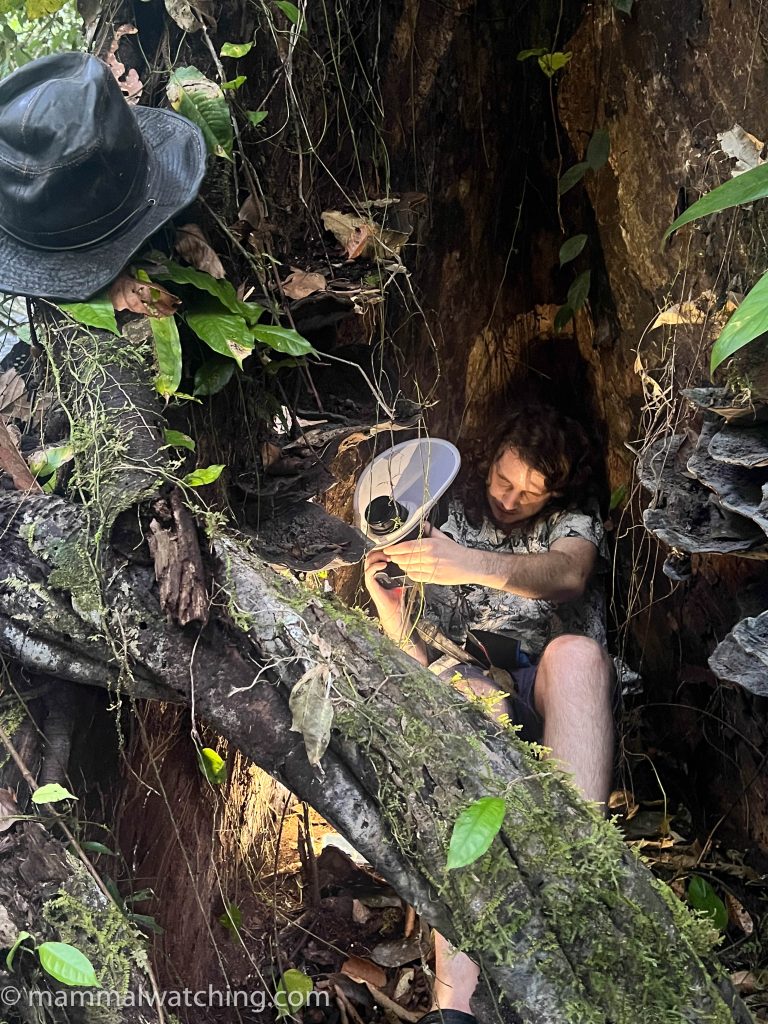
Beetle photography
We only had a night here. In the late afternoon we walked a couple of short trails in search of gibbons, which we couldn’t find, and Violin Beetles, which we did, much to my son’s delight.

Ridley’s Leaf-nosed Bat (Hipposideros ridleyi)
A hollow log close to camp was home to this Ridley’s Roundleaf Bat, a lifer for me (thank you Charles Francis for confirming the ID).
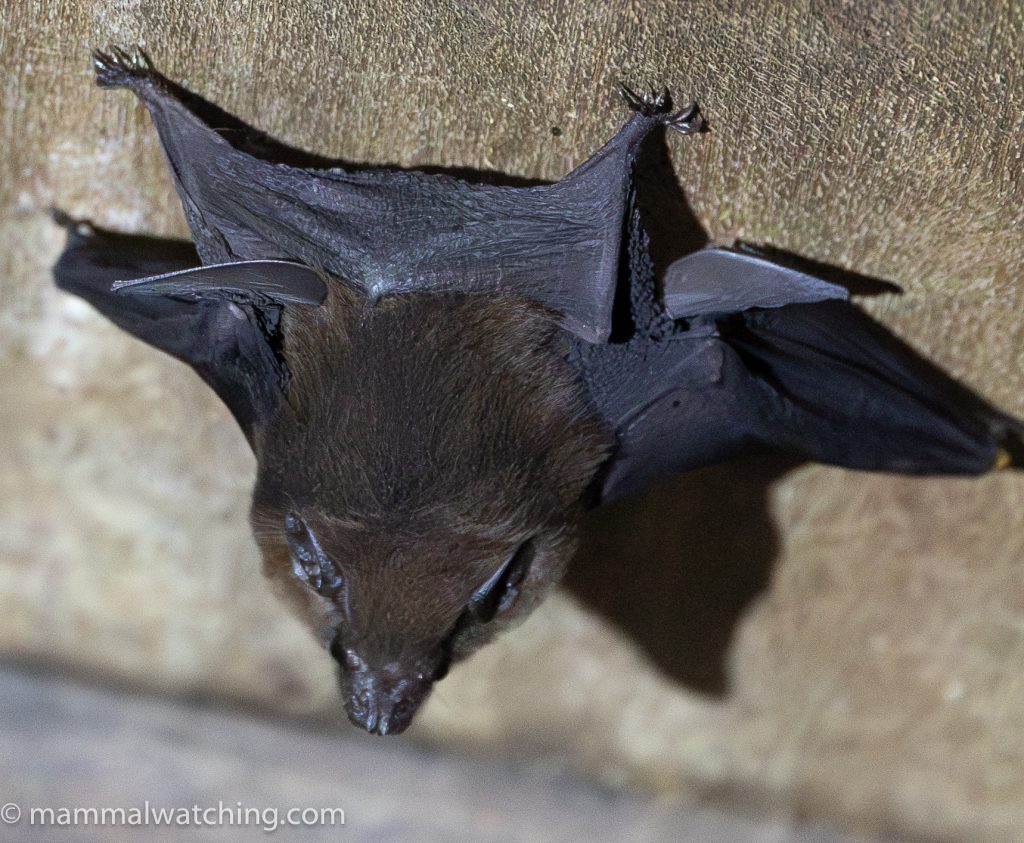
Small Asian Sheath-tailed Bat (Emballonura alecto)
And a few Small Asian Sheath-tailed Bats were roosting under the accommodation. We also saw Southern Pig-tailed Macaques and Maroon Langurs, which sleep near the park entrance every night.
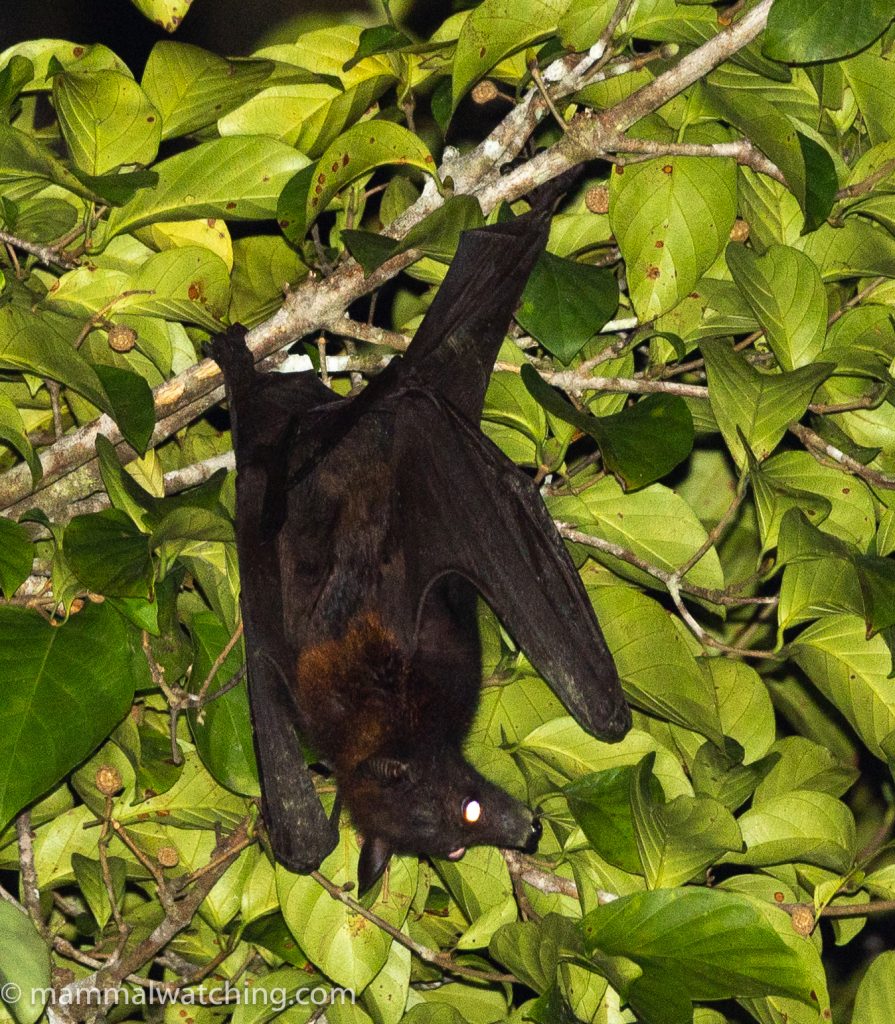
Large Flying Fox (Pteropus vampyrus)
A night walk, with other guests, around the lodge grounds was excellent with our first Colugo of the trip, Large Flying Foxes and a Red Giant Flying Squirrel, along with some nice snakes and frogs that Shavez found for us.
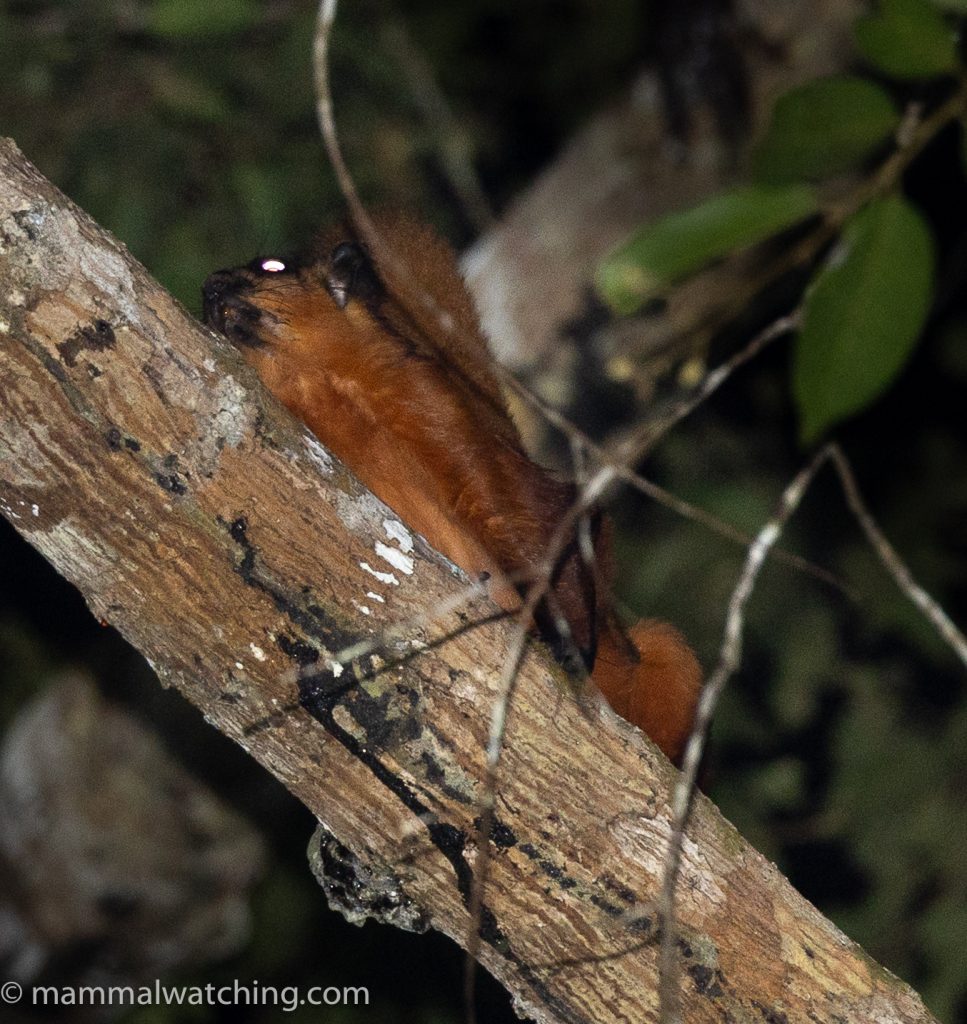
Red Giant Flying Squirrel (Petaurista petaurista)
Kat and I took a second walk, a little deeper into the forest, and saw two more mammals.
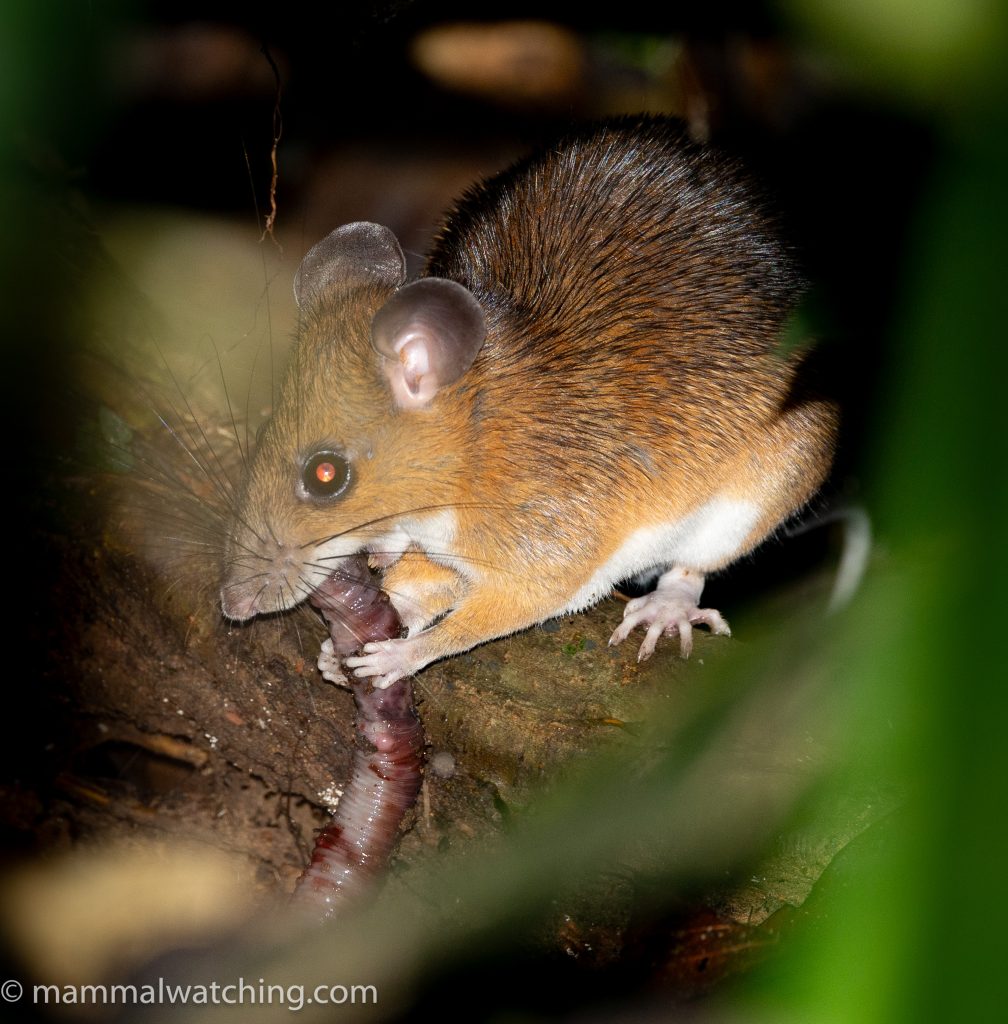
Indomalayan Spiny Rat (Maxomys surifer)
This Indomalayan Spiny Rat was happy to pose for photos while it munched on an earthworm.
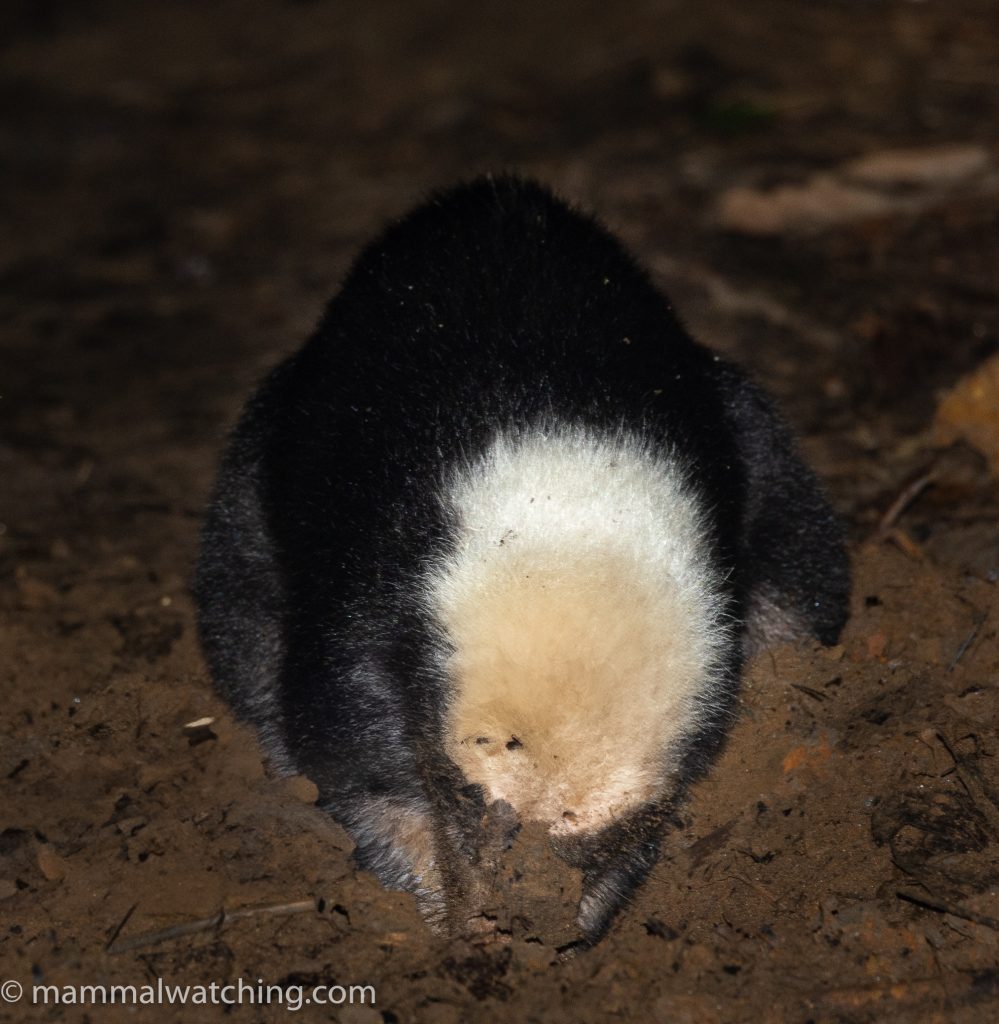
Sunda Stink Badger (Mydaus javanensis)
As was this Sunda Stink Badger, which seemed totally oblivious to our flashlight as it too foraged, presumably for worms.

Horsfield’s Short-nosed Fruit Bat (Cynopterus horsfieldii)
Local bat researchers were netting and had caught just one animal, a chunky Horsfield’s Short-nosed Fruit Bat. And a Greater Mouse Deer was also lurking behind the accommodation.
The following morning, we took a last dawn walk in search of gibbons. We heard some calling, but the first serious rain of the week started falling so we had to abandon our search.
An hour later we were en route to Tawau Airport.
As with all the places we visited there is a lot of potential here too. For instance, Shavez just sent me a video of a Sunda Pangolin next to the Tawau accommodation.
Borneo has many surprises and she gives them up slowly.
Final Thoughts for Future Trips
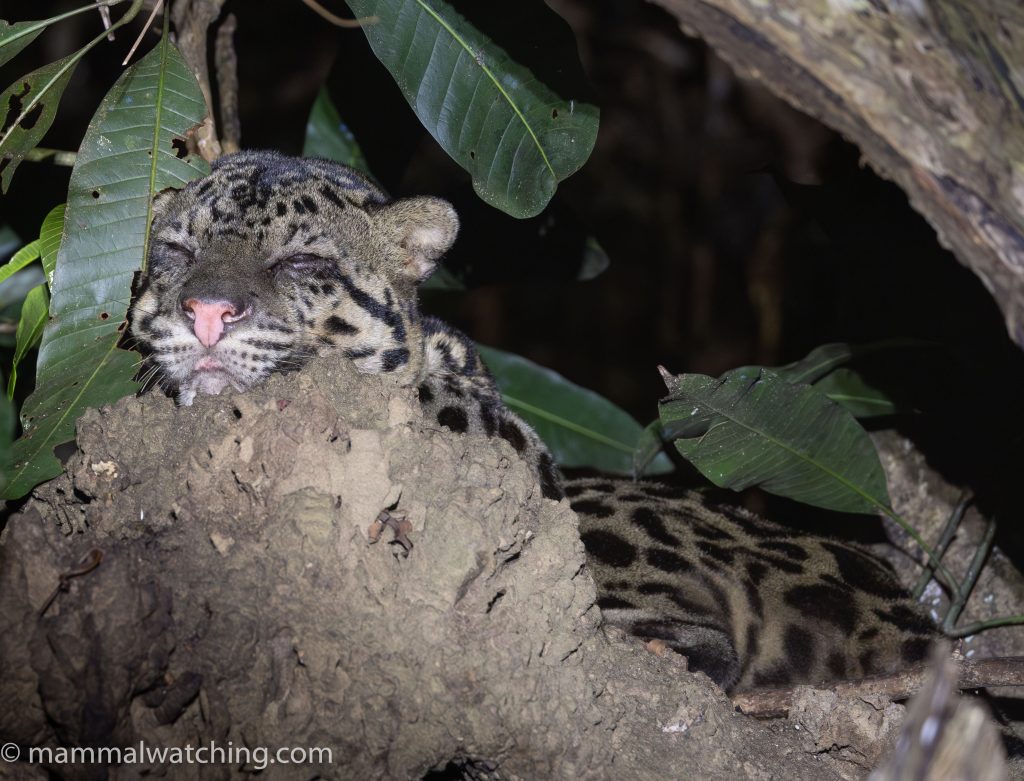
Sunda Clouded Leopard (Neofelis diardi), Kinabatangan River
If you are thinking of a trip to Borneo then you might now be asking yourself whether to go to Deramakot, Beluran or INIKEA?
As more people visit Beluran and INIKEA and we get more data we will get a better sense of whether they offer any genuine advantages or disadvantages for certain species.
As of August 2025, Shavez shared the following data from 1 Stop Borneo tours to the two places, mainly for two or three nights.
- 12 groups to Beluran have produced Marbled Cat twice, Clouded Leopard twice, Flat-headed Cat twice and a Sun Bear.
- 25 groups to INIKEA have produced Marbled Cat once (and been close twice) and Clouded Leopard four times.
So in particular the odds of a Clouded Leopard per night looking seem about the same.
If you prefer to have fewer people around you – which can be both an advantage and a disadvantage – then both places might be preferable to better known sites. Fewer cars on the road might make for a more enjoyable evening, and you should have more chance of coming across something walking along the road. But remember an absence of traffic means there is less chance of another guide texting you with news of a Clouded Leopard sitting in a tree down the track.
My initial hunch is that Beluran may prove better than Deramakot for Flat-headed Cat, worse for Orangutans and Otter Civets, and about the same for many other key species, including the cats. I don’t have any hunches about INIKEA yet.
I am absolutely not saying that we should abandon Deramakot and flock to these new sites. Deramakot is still delivering the goods! But these sites might be worth visiting alongside some of the more well-known places. Plus mixing up the destinations is likely to give you a longer trip list.
Beluran
After a week chasing clouded leopards in Deramakot, a change might be as good as a rest. So Beluran is well worth considering as an addition to your next trip, not least because you are helping to support a forestry reserve that appears to want to do the right thing for conservation. Mammalwatching is booming in Borneo and there is plenty of potential to open up more and more destinations.
INIKEA
Including INIKEA in a trip would also be worthwhile, particularly if you would like to visit somewhere new, though it is a full day’s drive from Deramakot, and is more of a commitment than Beluran. But if you are heading to Tawau Hills – which I enjoyed a lot – then it would be worth spending a night or two in INIKEA.
Tawau
Tawau is rather different. The mammalwatching is on foot here, so you are going to have much less chance of spotting a clouded leopard. But it’s lovely forest, with some excellent bats and good chances for many interesting smaller mammals.
Mike Gordon has said that it is a bit of a fool’s errand to believe any one park is better for species like Clouded Leopard and Marbled Cats. Our chances are improved primarily by time in good habitat, good guides, and the ability to drive a lot at night. A lucky hat might also help.
Thanks
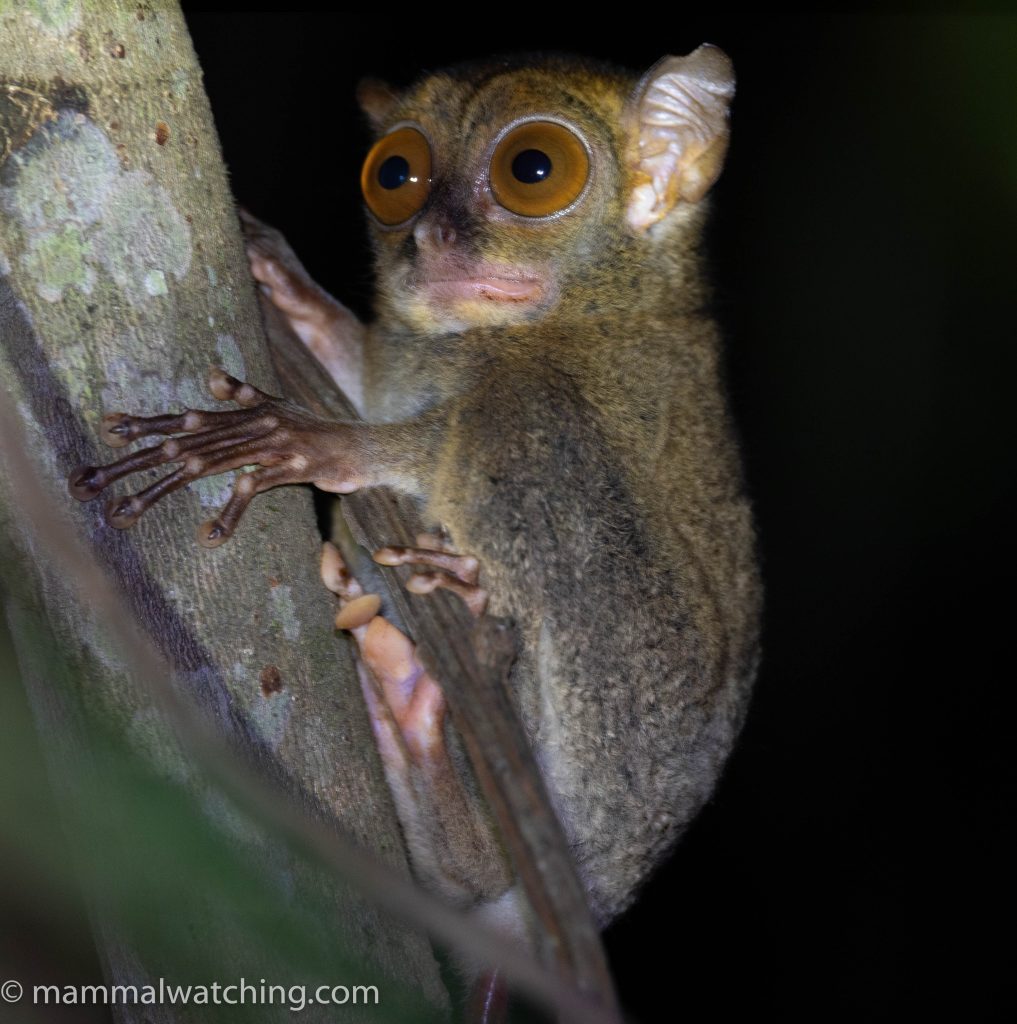
Western Tarsier (Cephalopachus bancanus)
A massive thanks to Shavez for making this trip happen so fast, and ensuring it was so enjoyable. He’s a good guide, passionate about conservation and also is a lot of fun to travel with. He was also excellent at letting us know what the plans are for the day and all that important stuff. My kids were delighted that he was running the trip and not me. Also, a very big thank you Chun Wong, Shavez’s partner at 1Stop Borneo, who is extremely knowledgeable about nature, and phenomenal at finding reptiles in particular. It was hard to believe how many snakes and frogs he spotted.
It was great to catch up with Mike Gordon, who I have enormous respect for, and so I was very happy that my kids could meet him. They are now also big fans, and are still talking about his horror stories involving leeches.
And thank you to Juliana Senawi and Charles Francis for patiently answering my very many bat queries. Any ID mistakes are of course mine. Charles is a superb bat photographer and has run bat photography workshops with 1Stop Borneo. I would love to join the next one! Check out his photos here.
Trip List
Asian Elephant (Elephas maximus)
Sunda Colugo (Galeopterus variegatus)
Long-tailed Macaque (Macaca fascicularis)
Southern Pig-tailed Macaque (M.nemestrina)
Proboscis Monkey (Nasalis larvatus)
Maroon Langur (Presbytis rubicunda)
Bornean Orangutan (Pongo pygmaeus)
Eastern Gray Gibbon (Hylobates funereus) (heard)
Western Tarsier (Cephalopachus bancanus)
Philippine Slow Loris (Nycticebus menagensis)
Prevost’s Squirrel (Callosciurus prevostii)
Tufted Pygmy Squirrel (Exilisciurus whiteheadi)
Sculptor Squirrel (Glyphotes simus) – endemic
Black Flying Squirrel (Aeromys tephromelas)
Thomas’s Flying Squirrel (A.thomasi)
Red Giant Flying Squirrel (Petaurista petaurista)
Indomalayan Long-tailed Giant Rat (Leopoldamys sabanus)
Indomalayan Spiny Rat (Maxomys surifer)
Lesser Short-nosed Fruit Bat (Cynopterus brachyotis)
Horsfield’s Short-nosed Fruit Bat (C.horsfieldii)
Minute Short-nosed Fruit Bat (C.minutus)
Lesser Long-tongued Blossom Bat (Macroglossus minimus)
Large Flying Fox (Pteropus vampyrus)
Greater Dawn Bat (Eonycteris major)
Lesser Dawn Bat (E.spelaea)
Fawn-colored Leaf-nosed Bat (Hipposideros cervinus)
Diadem Leaf-nosed Bat (H.diadema)
Ridley’s Leaf-nosed Bat (H.ridleyi)
Creagh’s Horseshoe Bat (Rhinolophus creaghi)
Trefoil Horseshoe Bat (R.trifoliatus)
Small Asian Sheath-tailed Bat (Emballonura alecto)
Little Long-fingered Bat (Miniopterus australis)
Doria’s False Serotine (Hesperoptenus cf. doriae) – endemic
Narrow-winged Pipistrelle (Pipistrellus stenopterus)
Sumatran Greater Bamboo Bat (Tylonycteris robustula)
Sunda Stink Badger (Mydaus javanensis)
Sunda Leopard Cat (Prionailurus javanensis)
Sunda Clouded Leopard (Neofelis diardi)
Banded Palm Civet (Hemigalus derbyanus)
Binturong (Arctictis binturong)
Small-toothed Palm Civet (Arctogalidia trivirgata)
Masked Palm Civet (Paguma larvata)
Philippine Palm Civet (Paradoxurus philippinensis)
Malay Civet (Viverra tangalunga)
Sambar (Rusa unicolor)
Bornean Yellow Muntjac (Muntiacus atherodes)
Lesser Indo-Malayan Chevrotain (Tragulus kanchil)
Greater Indo-Malayan Chevrotain (T.napu)
48 species with 6 lifers.
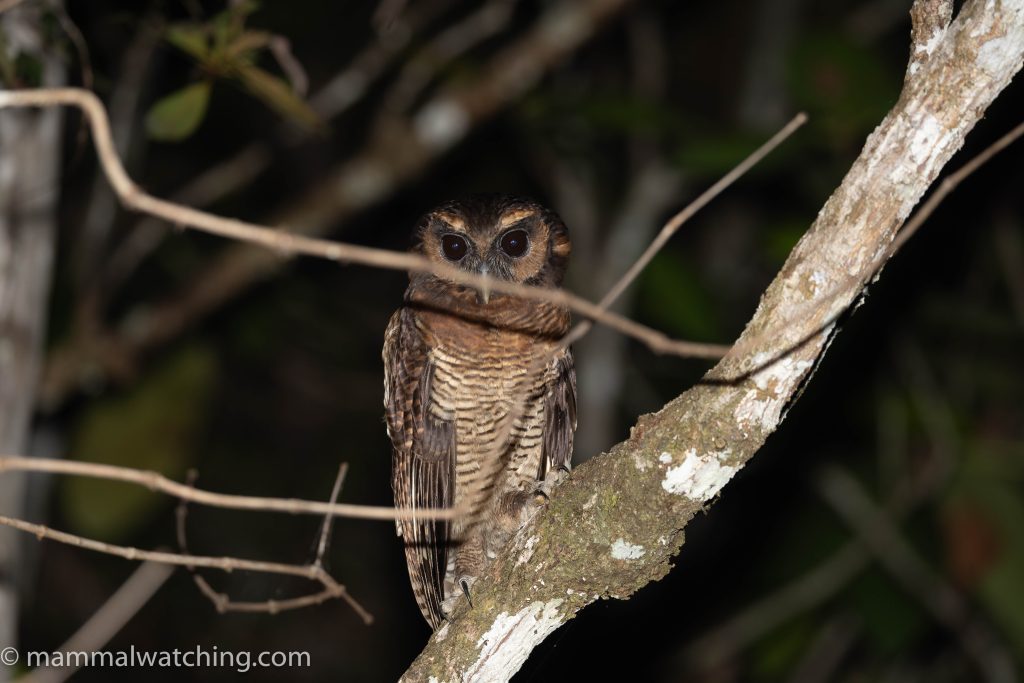
We also saw some birds
Post author


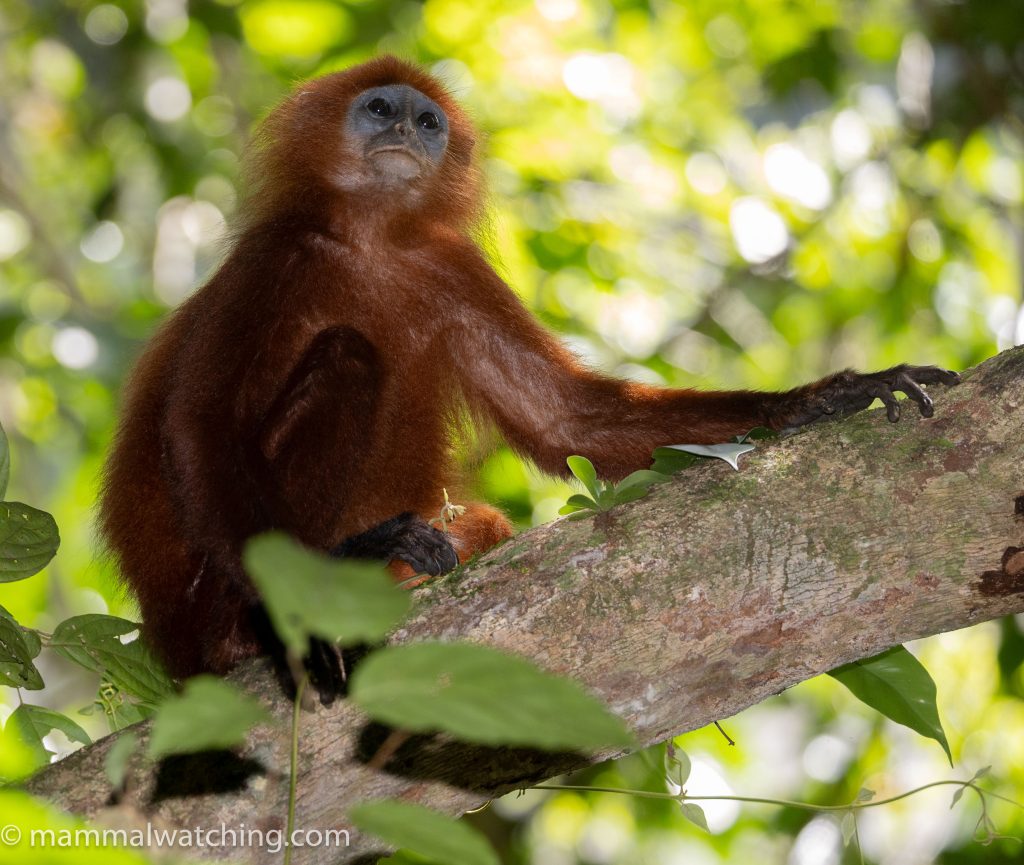
Leave a Reply
You must be logged in to post a comment.